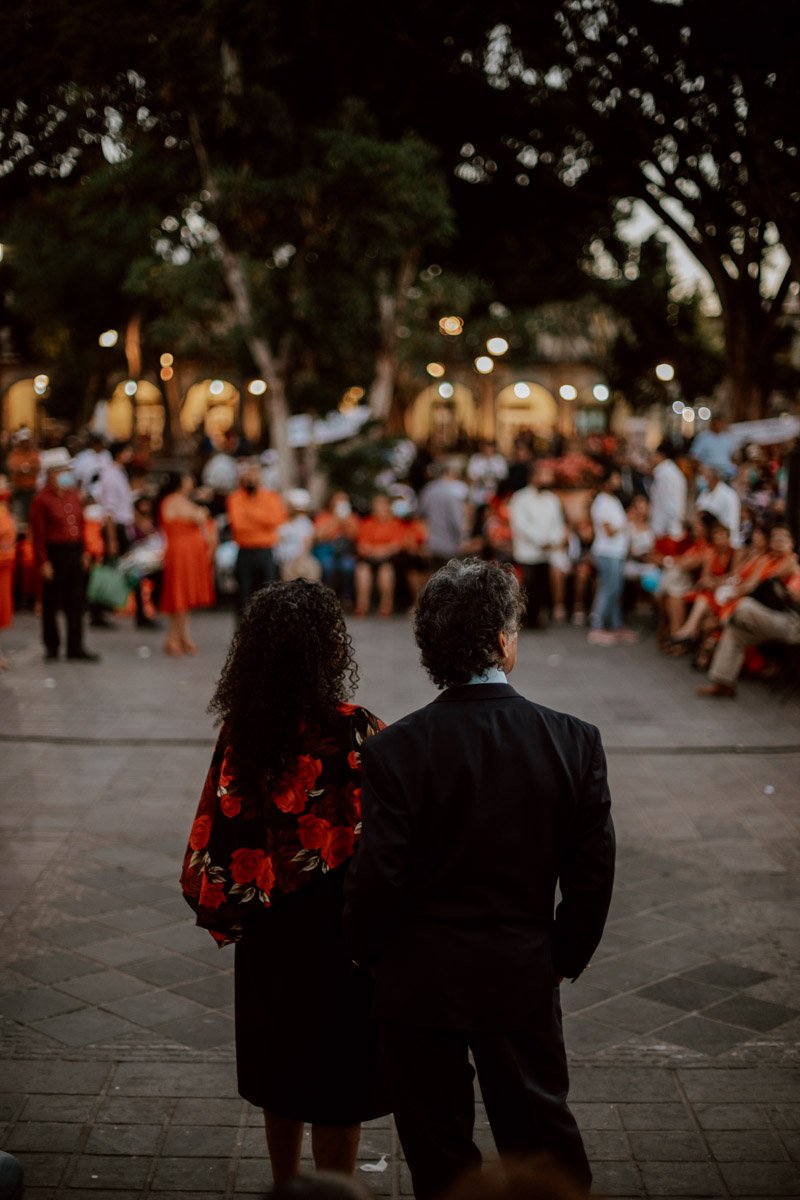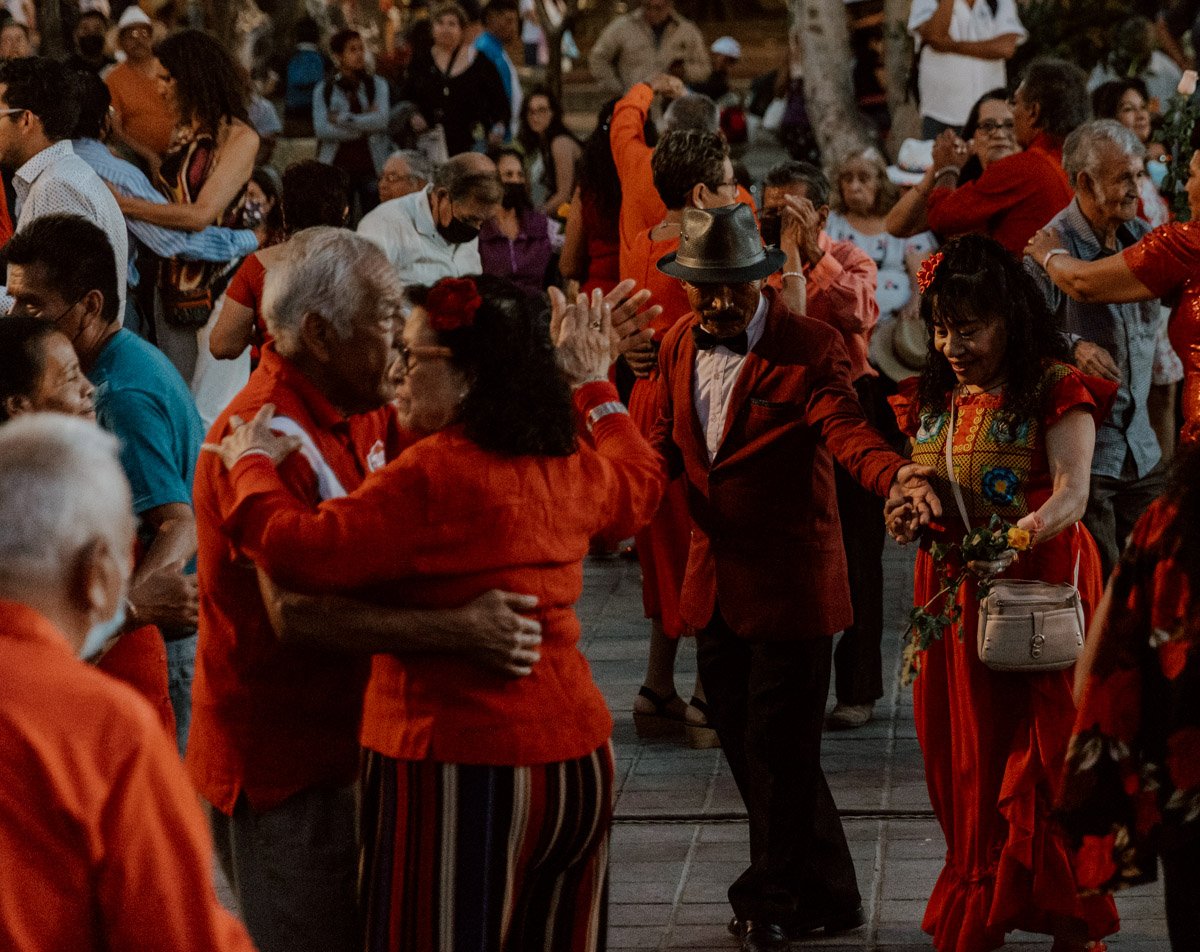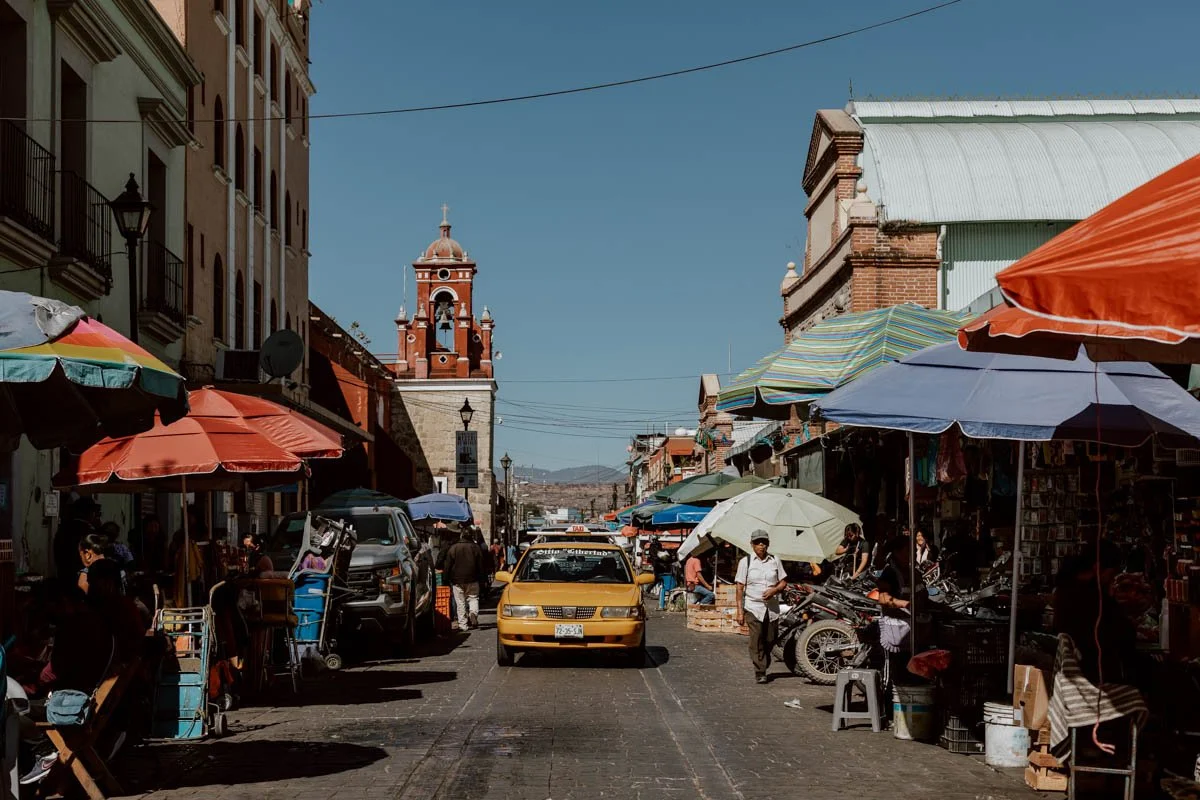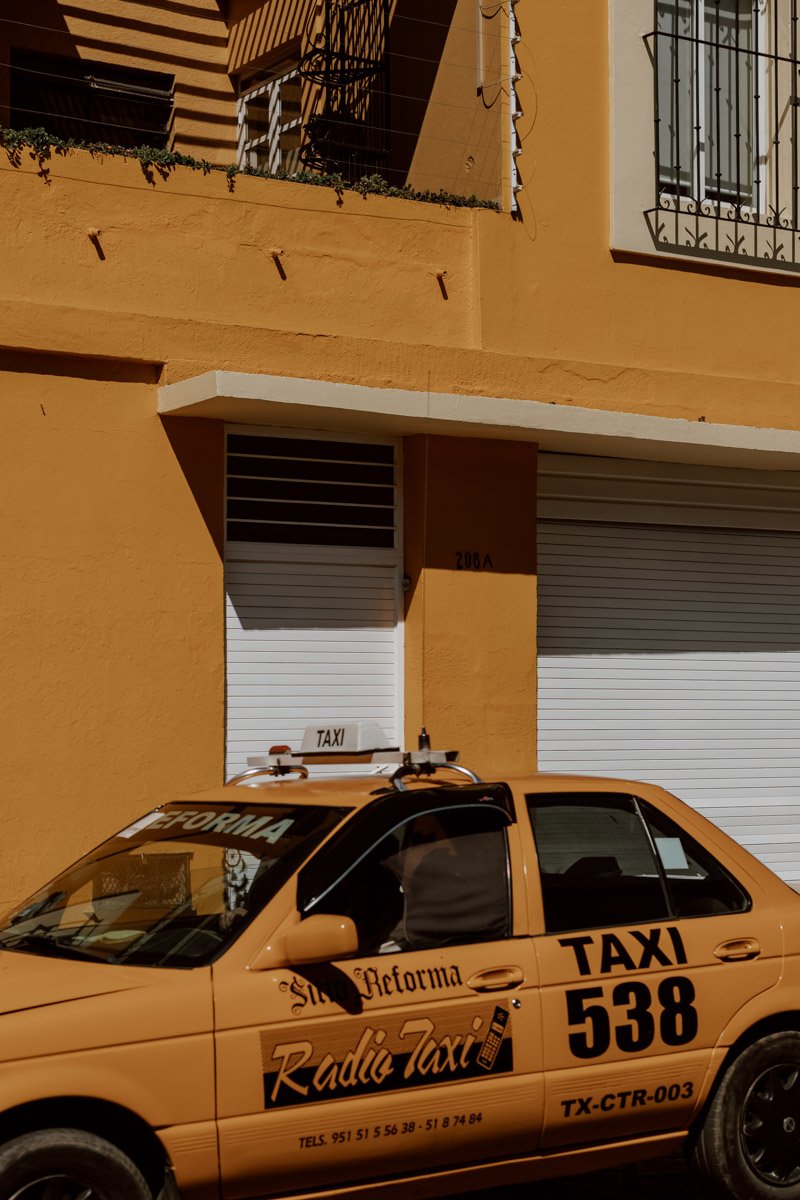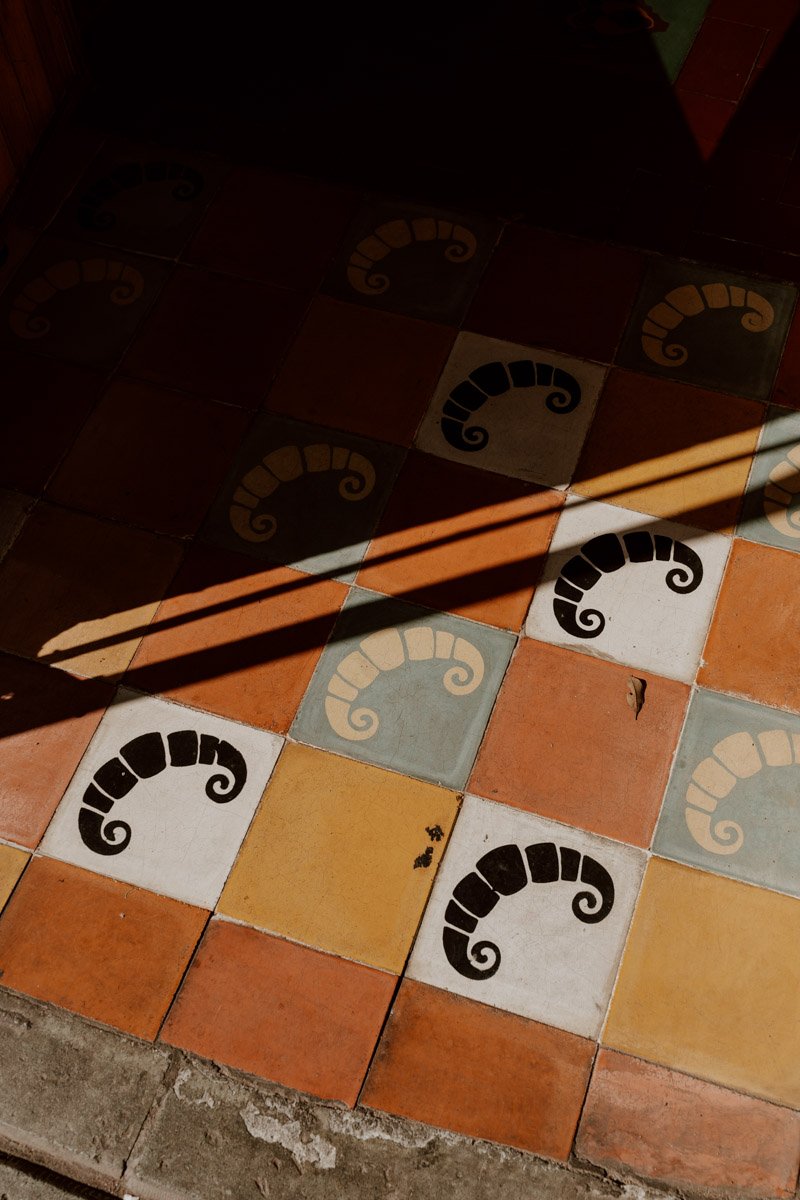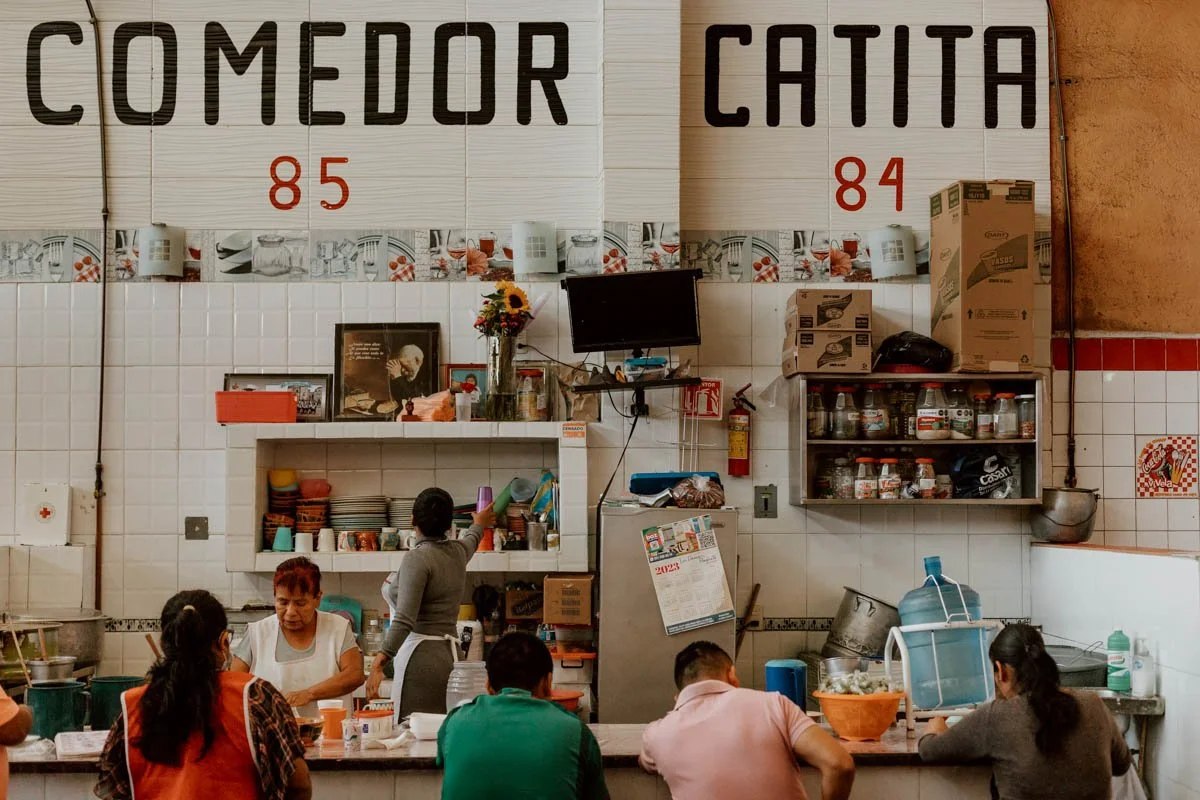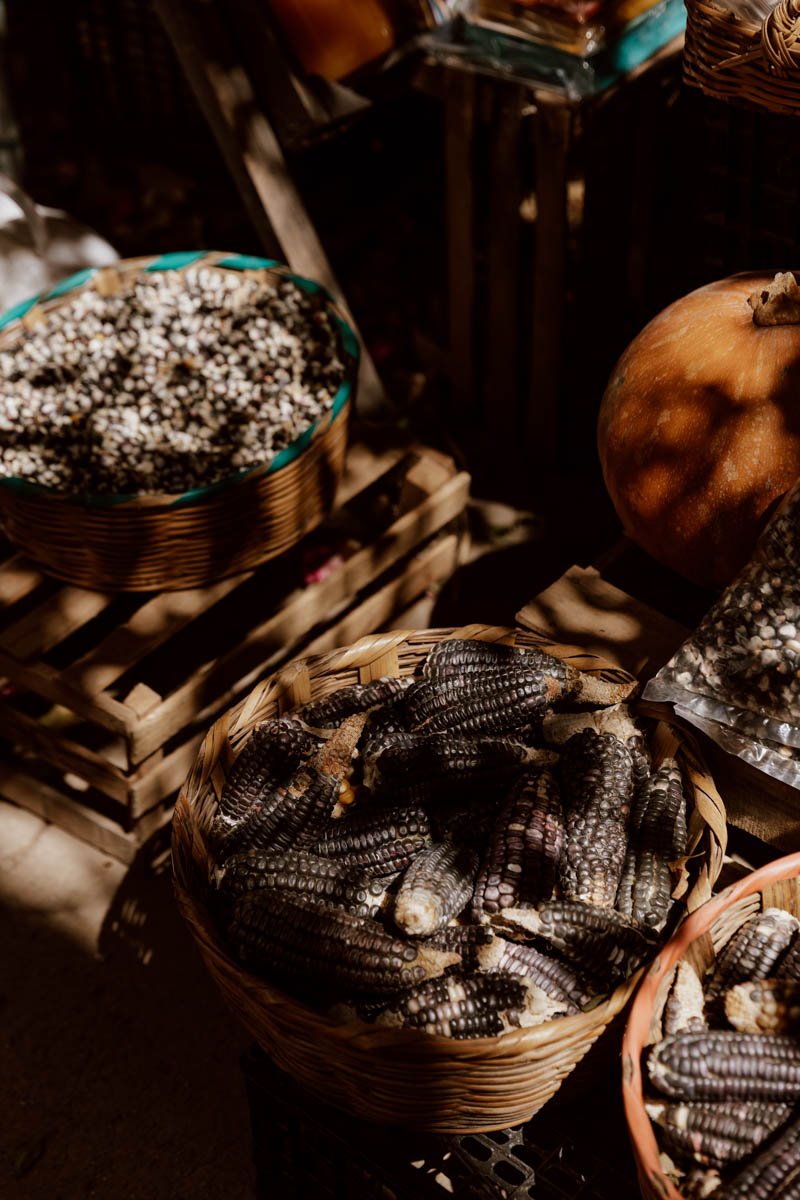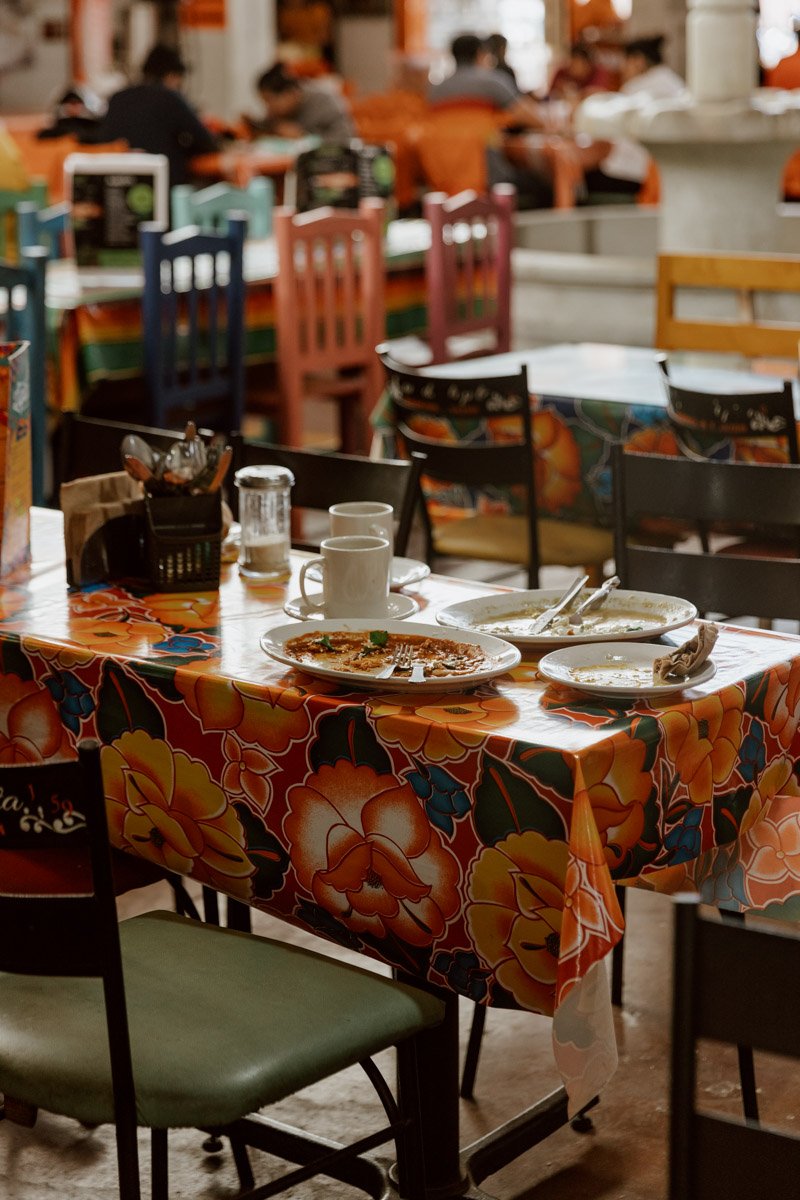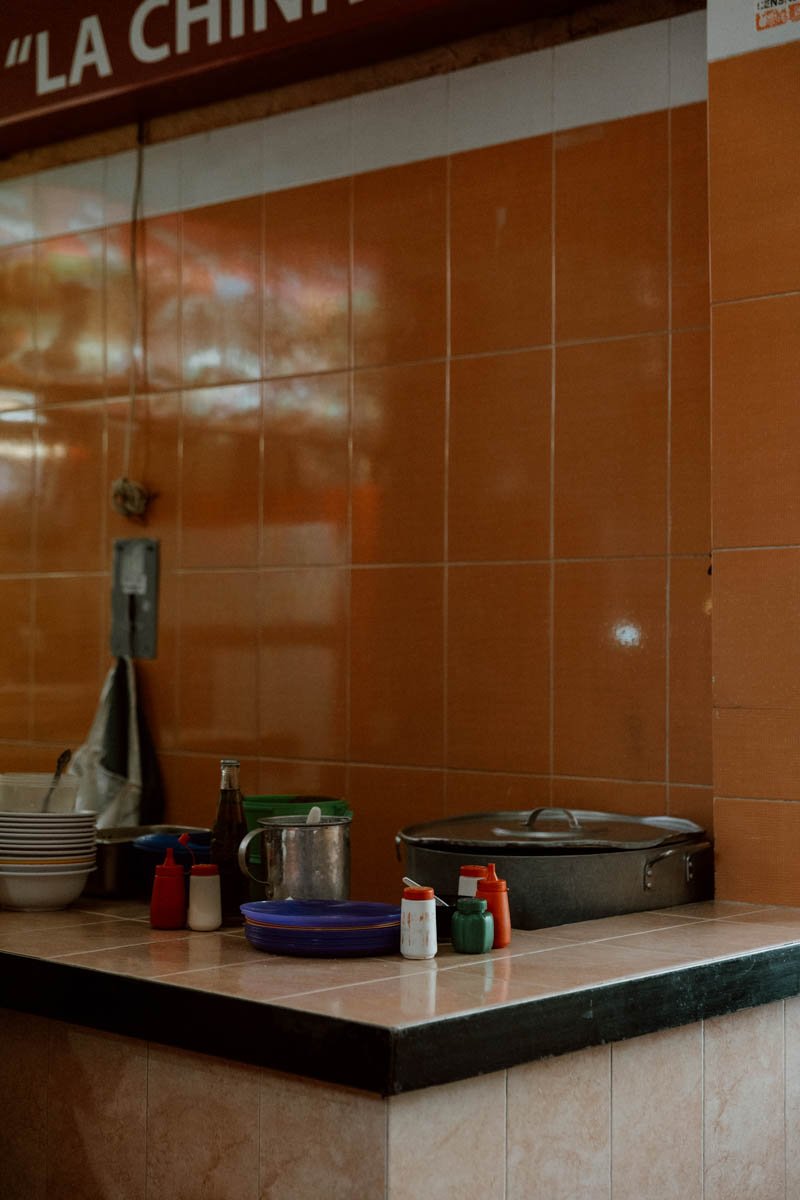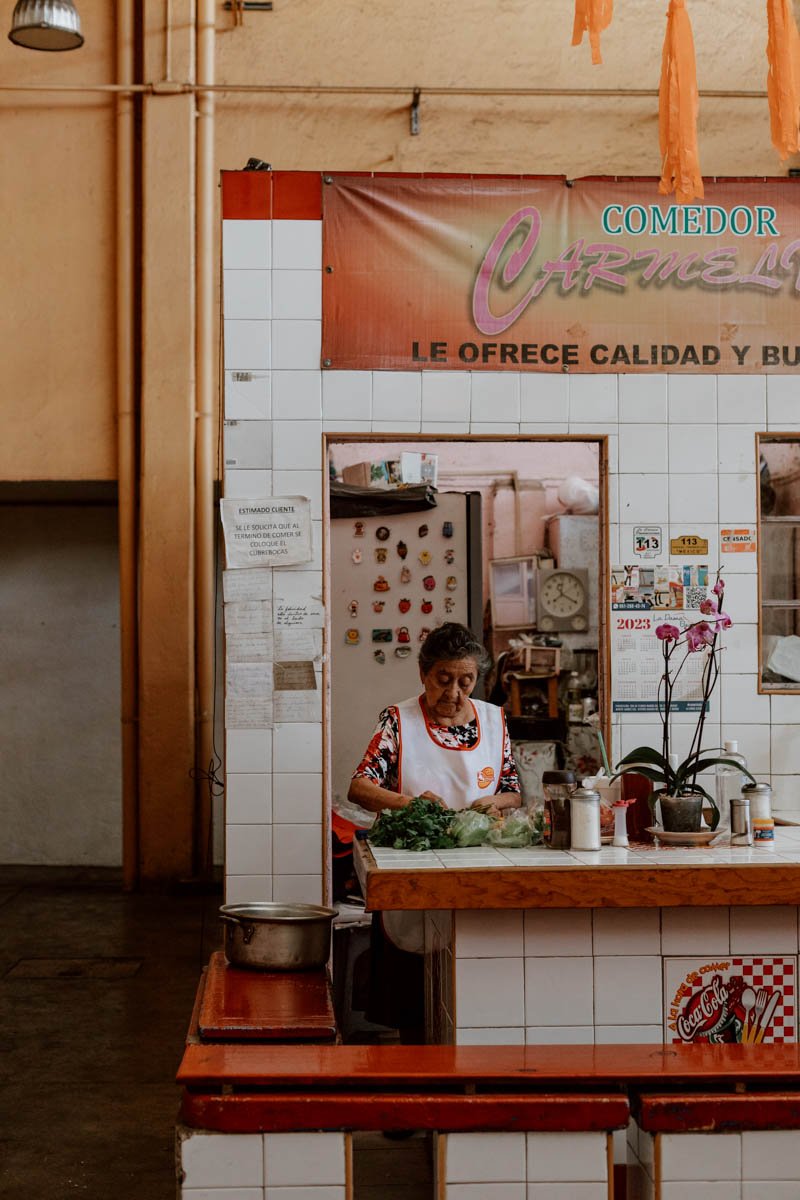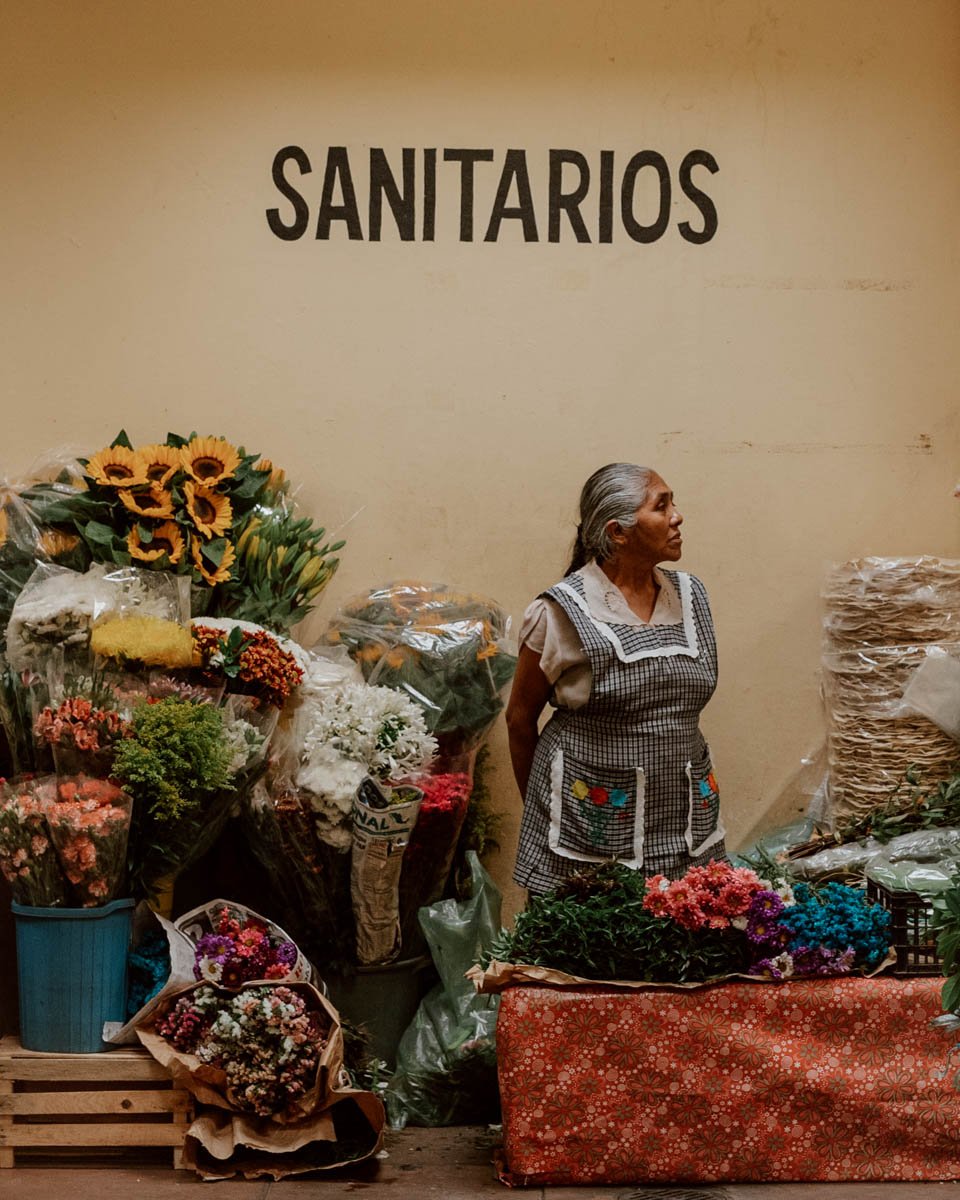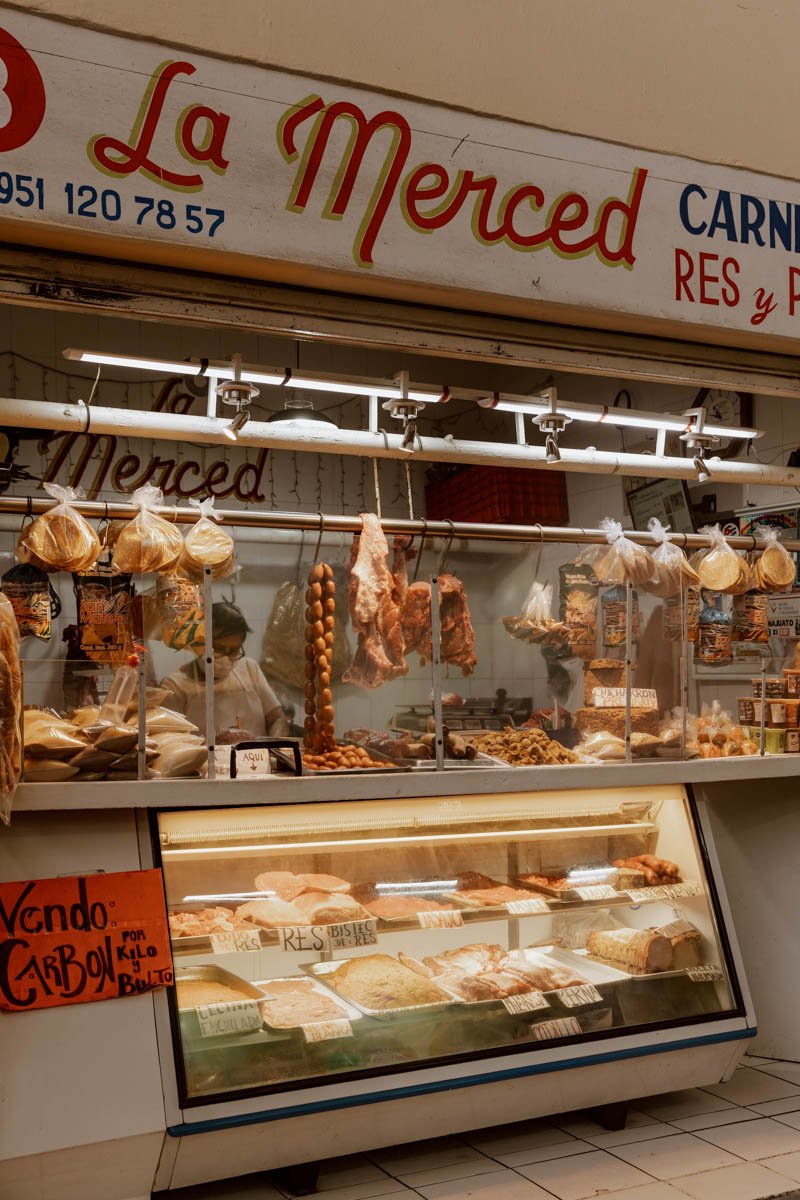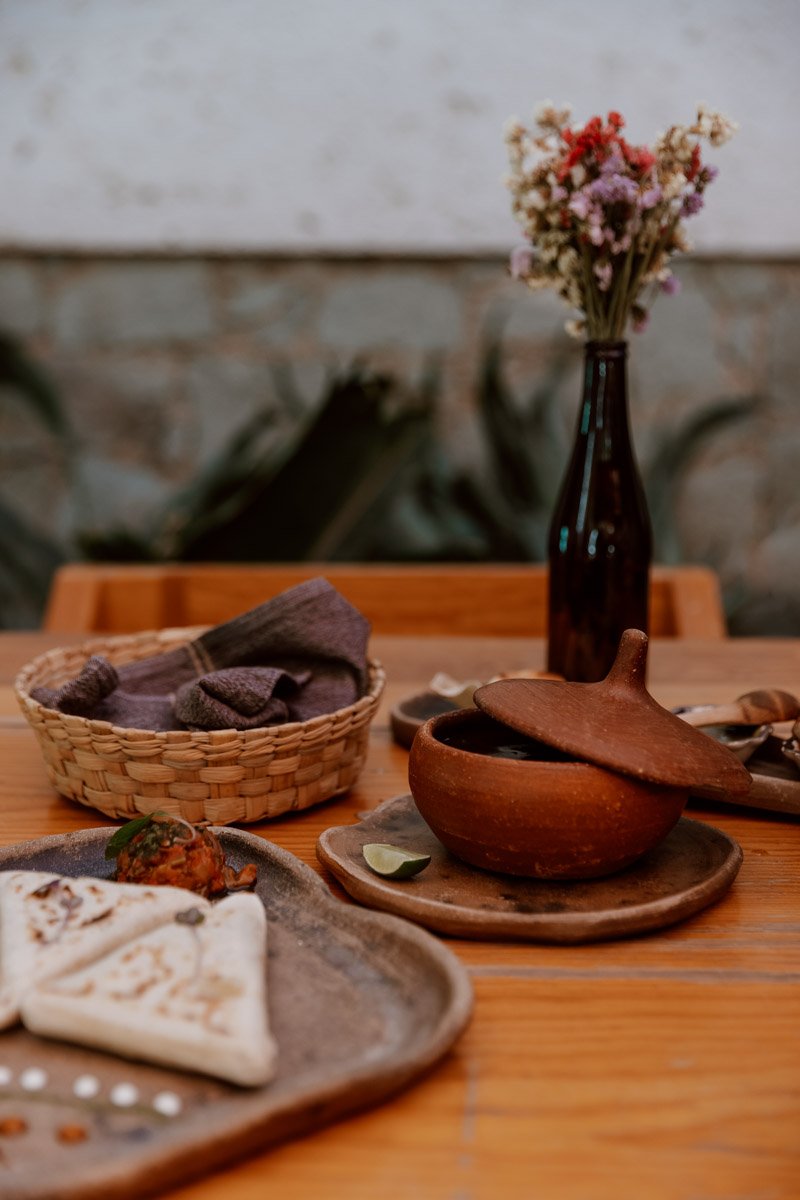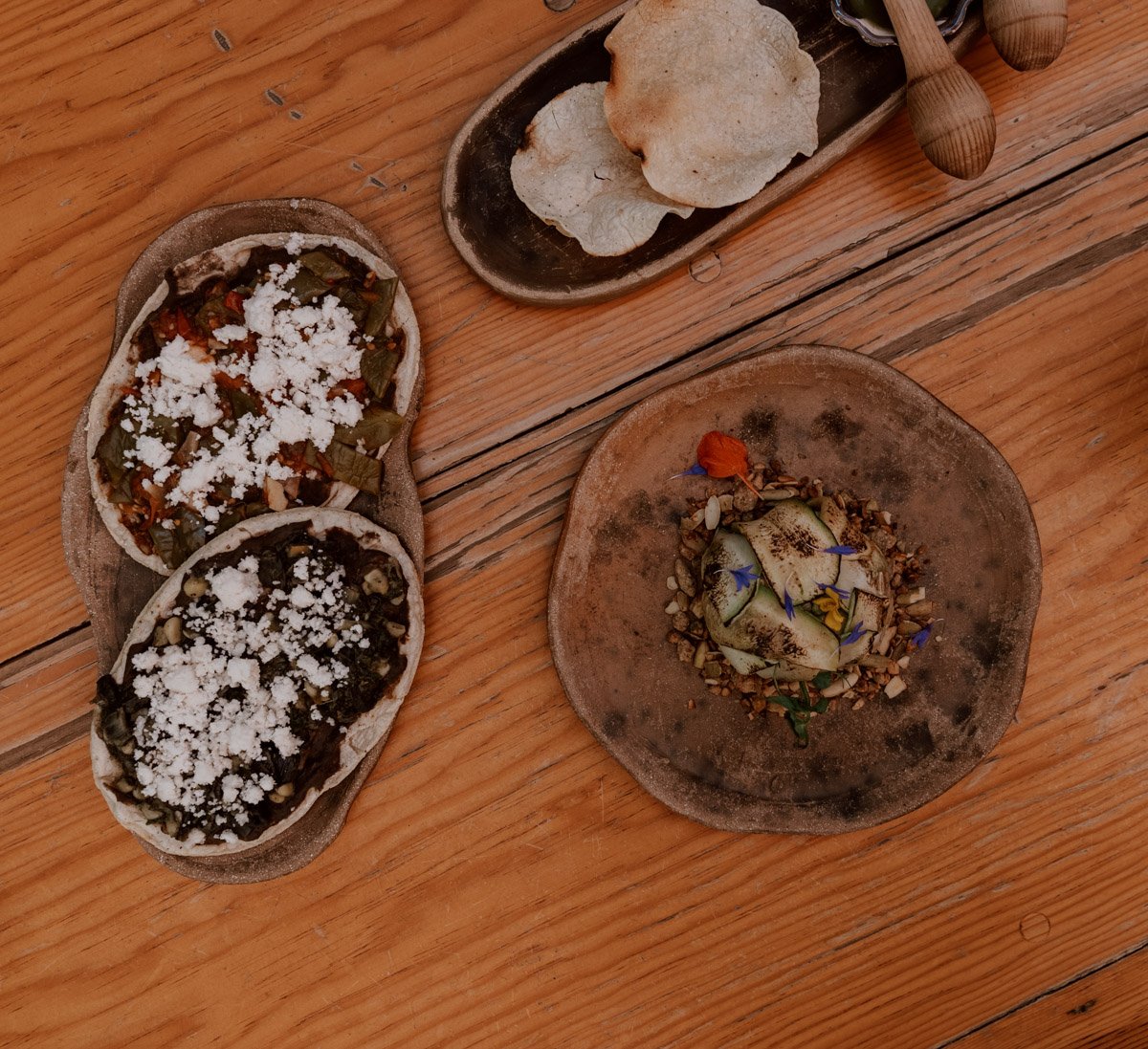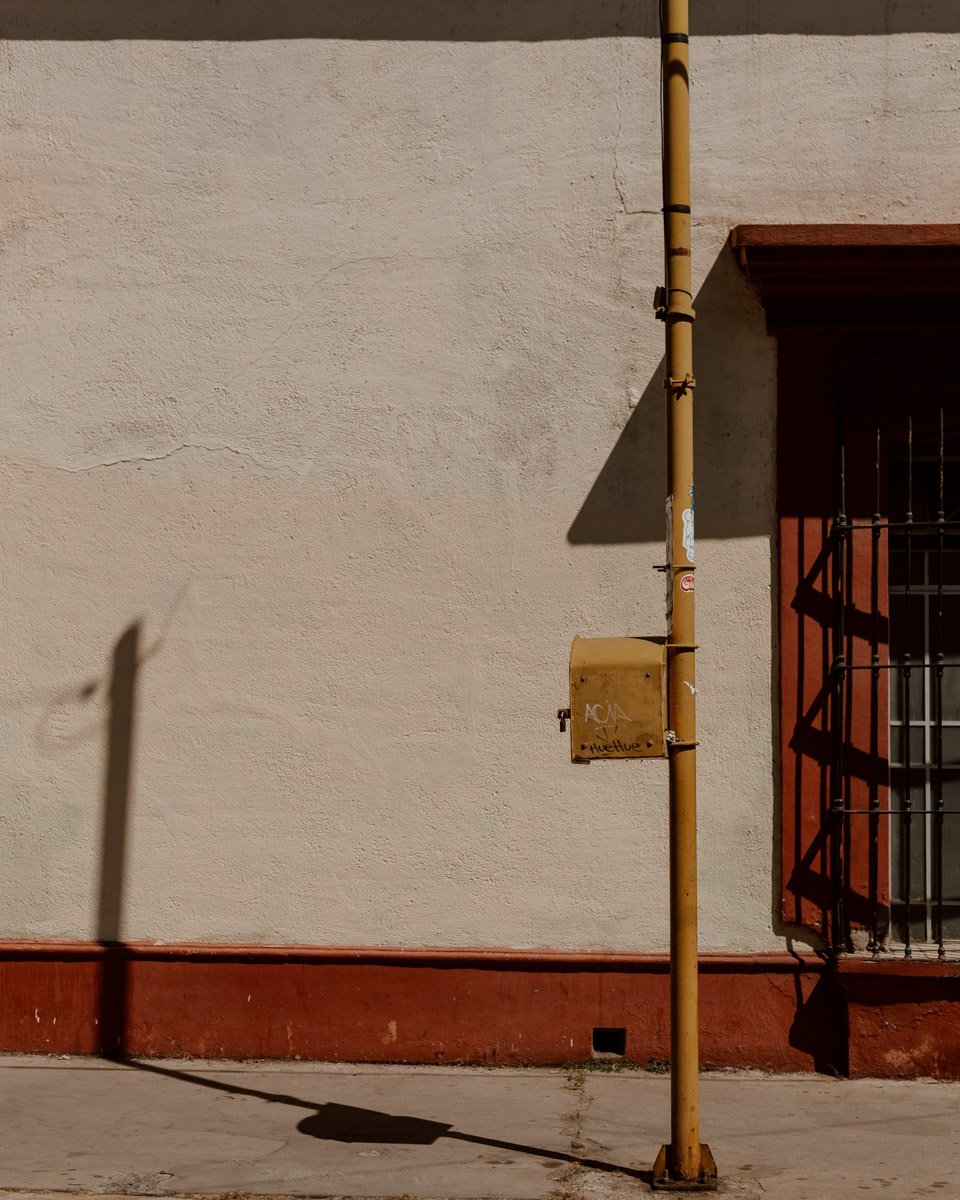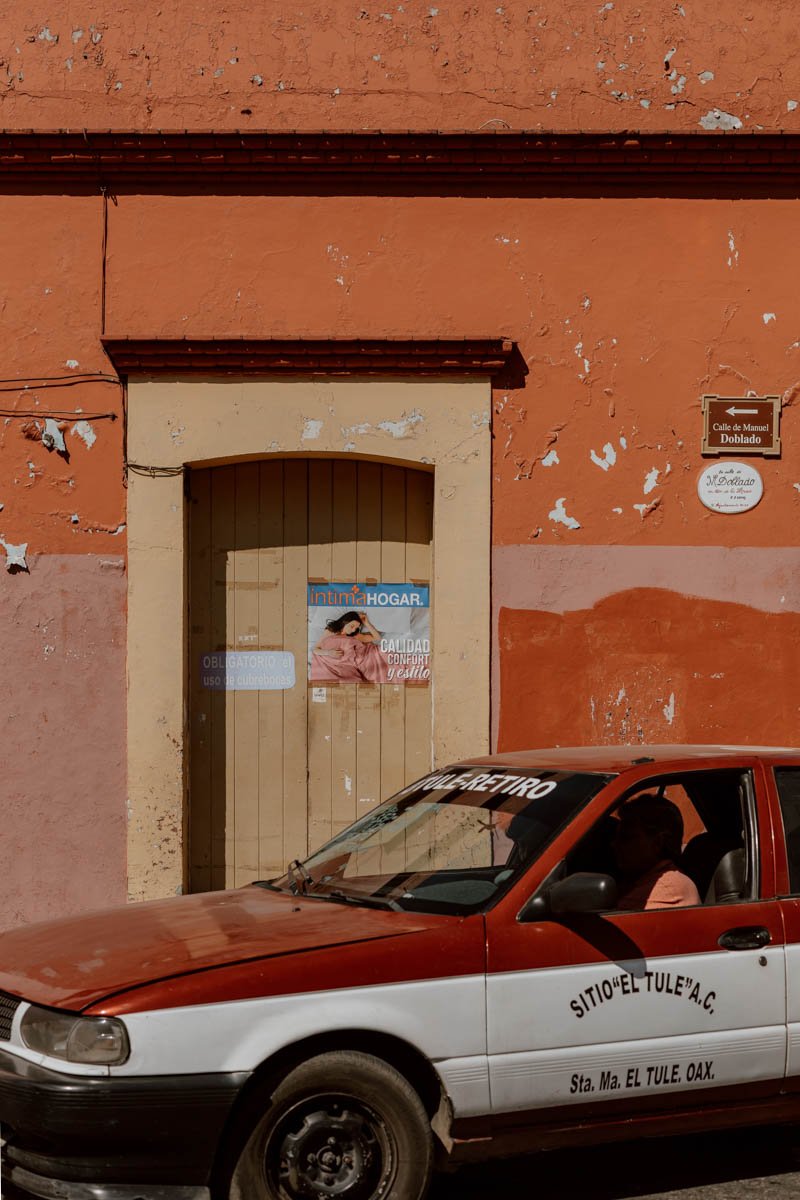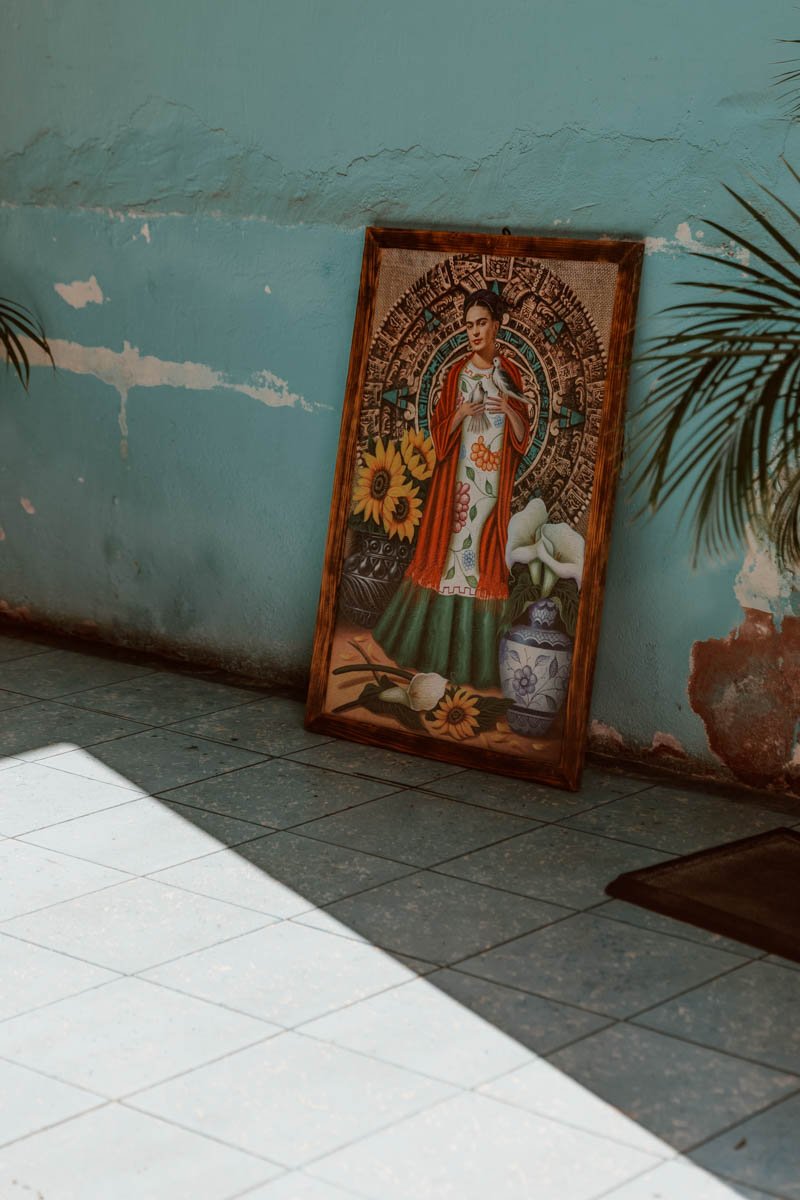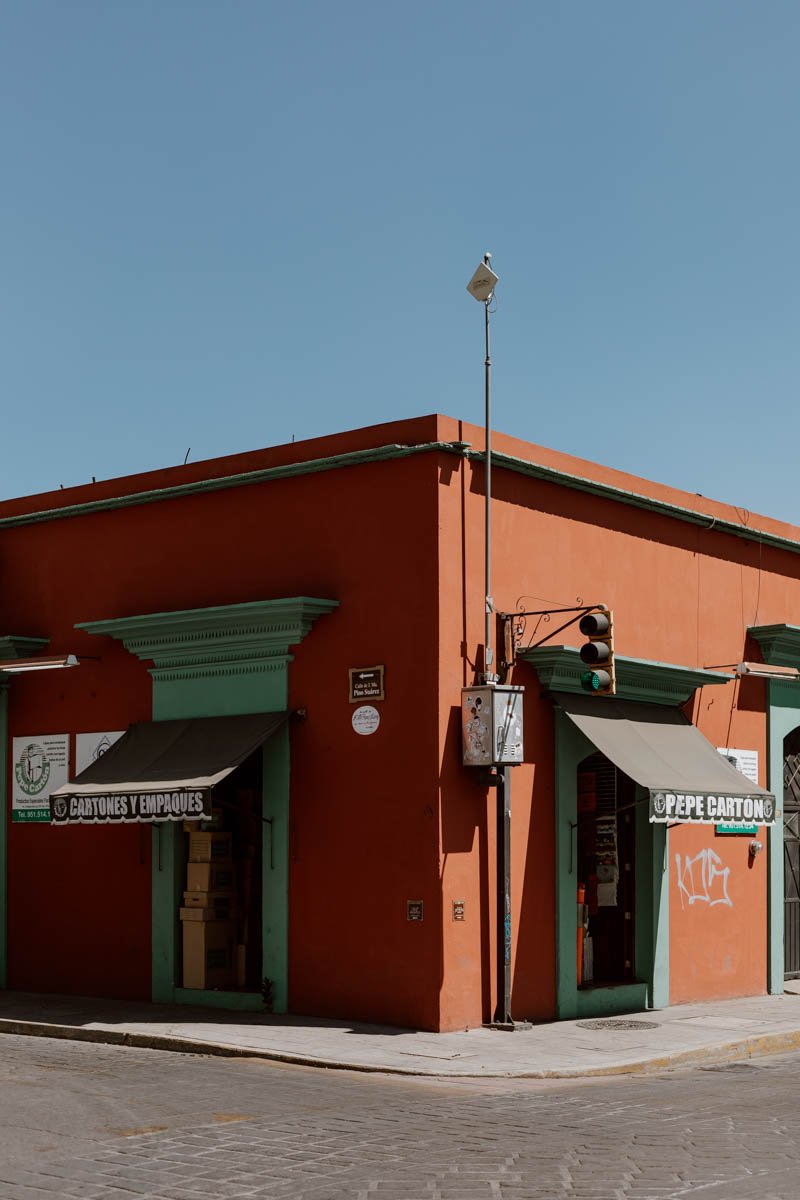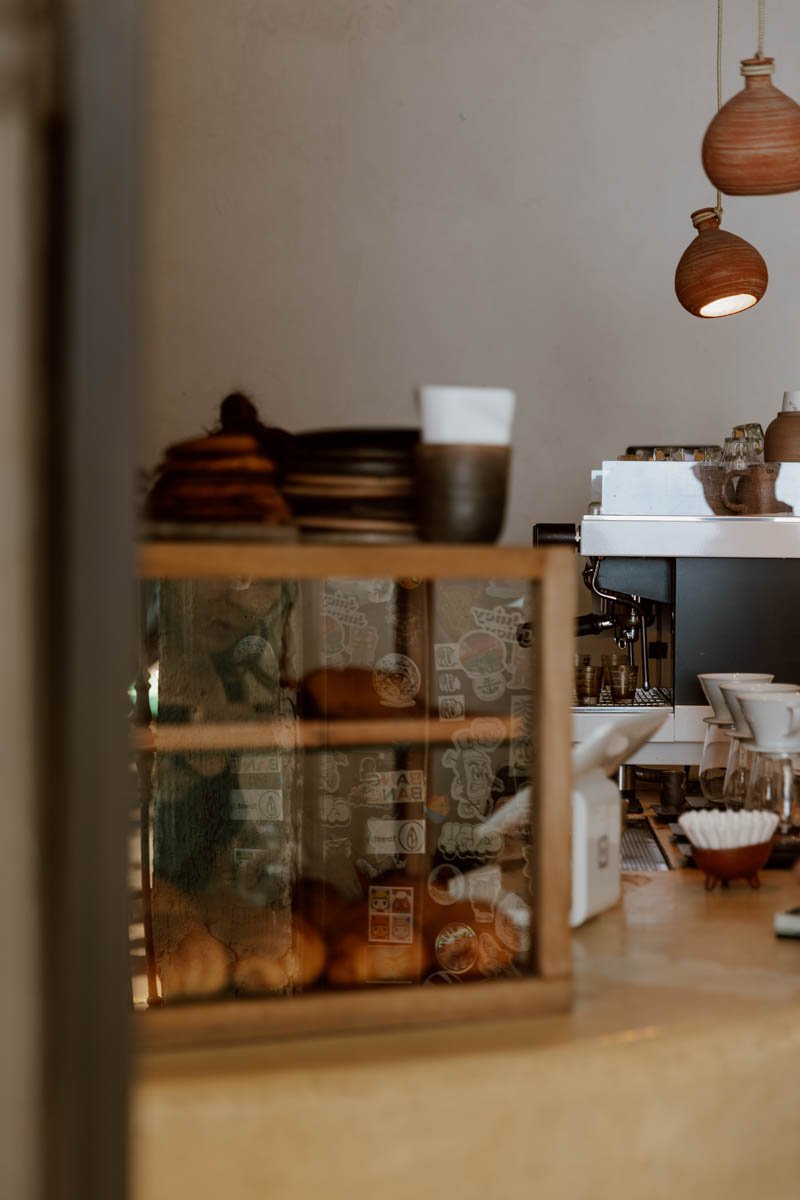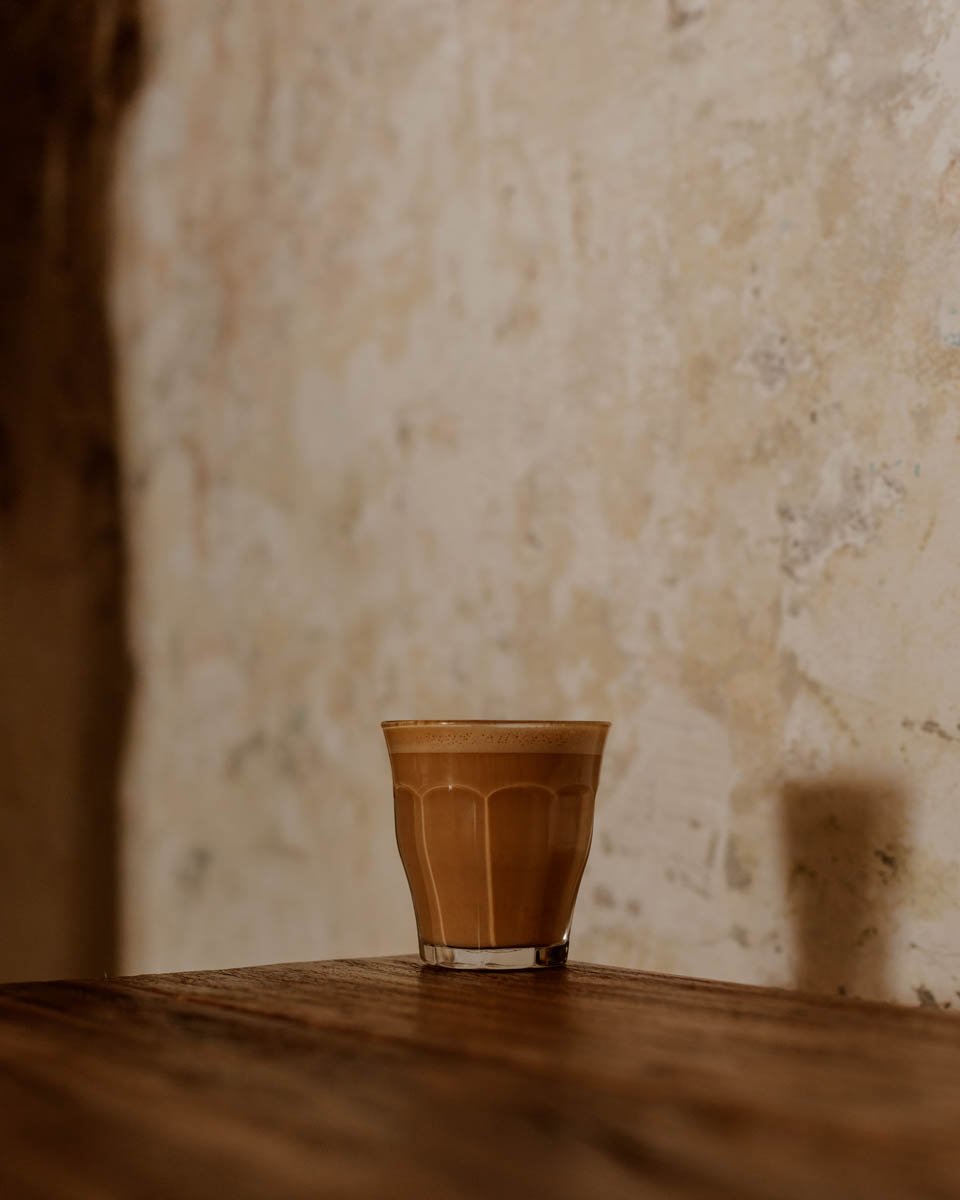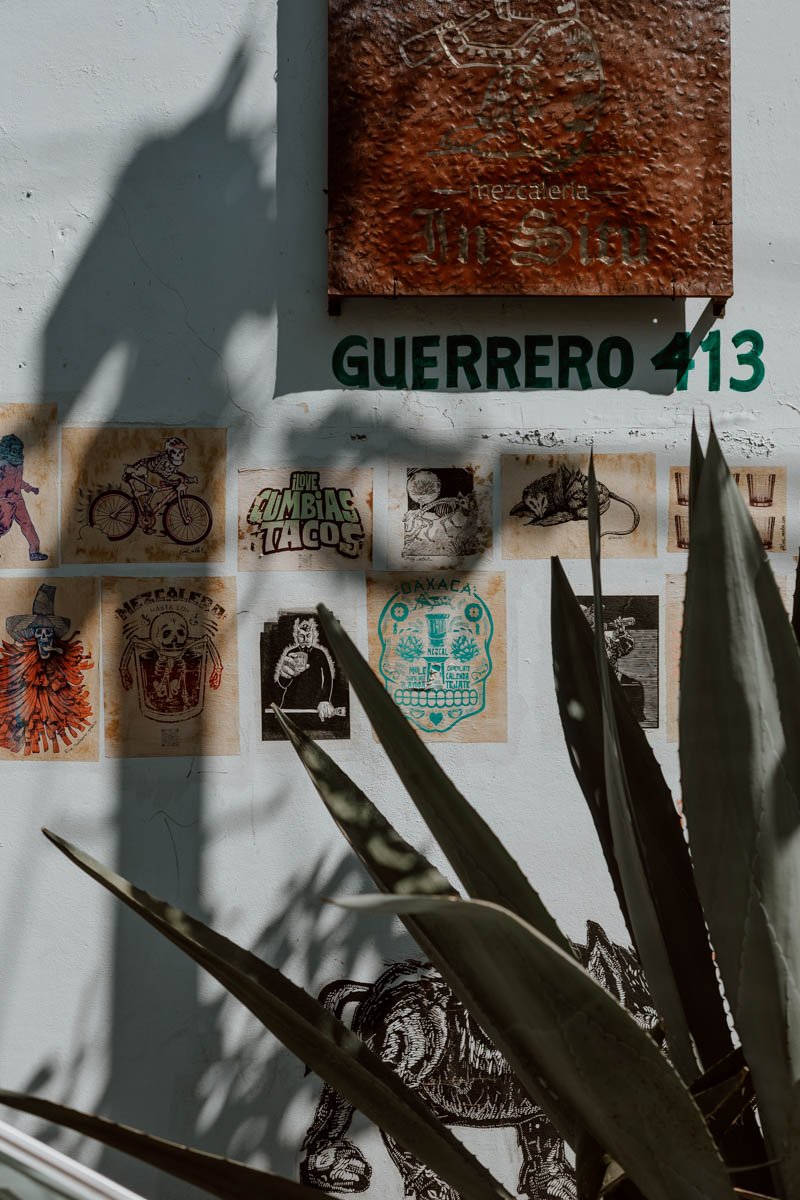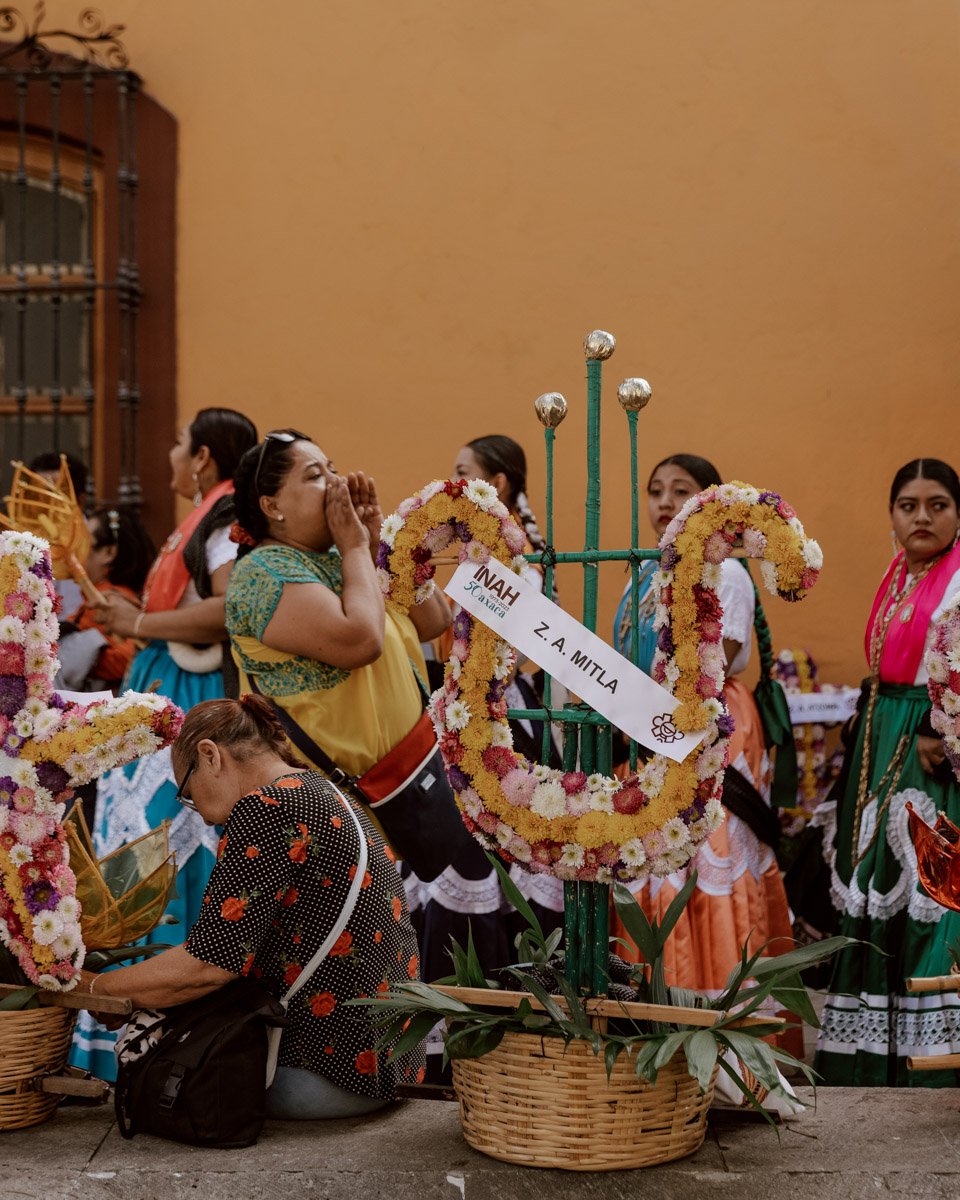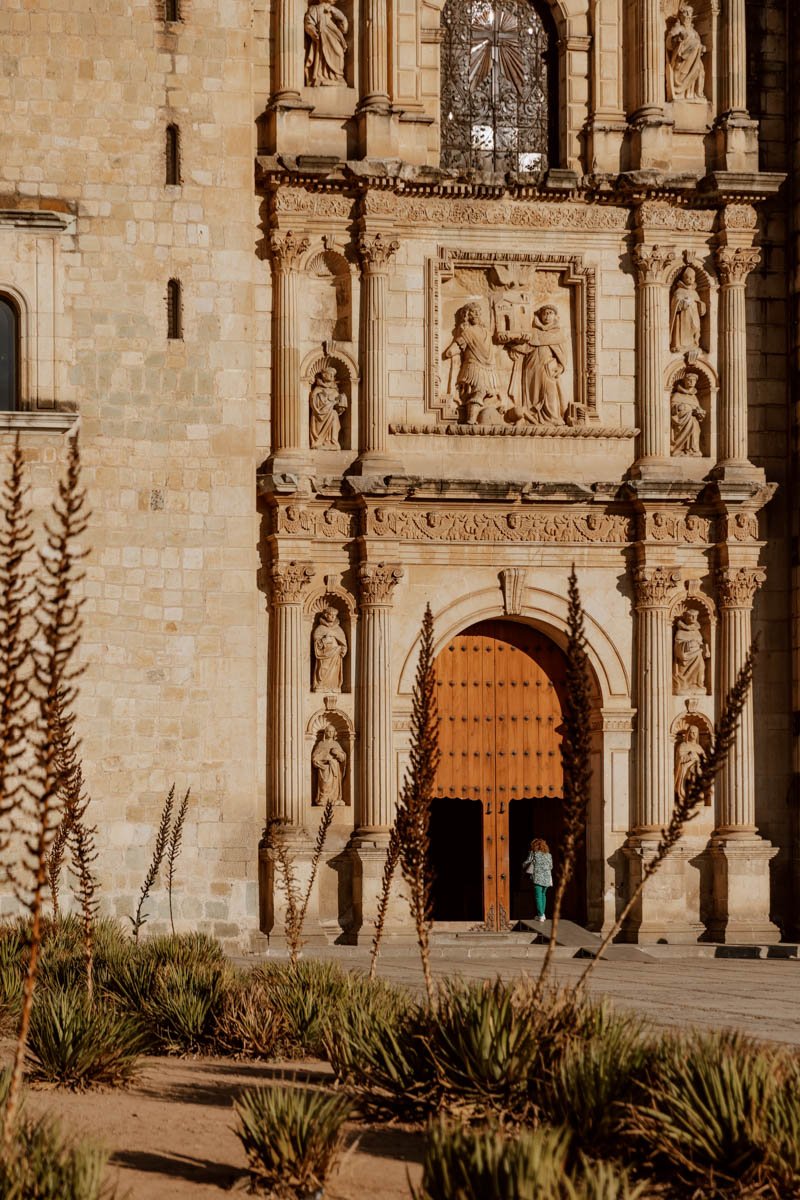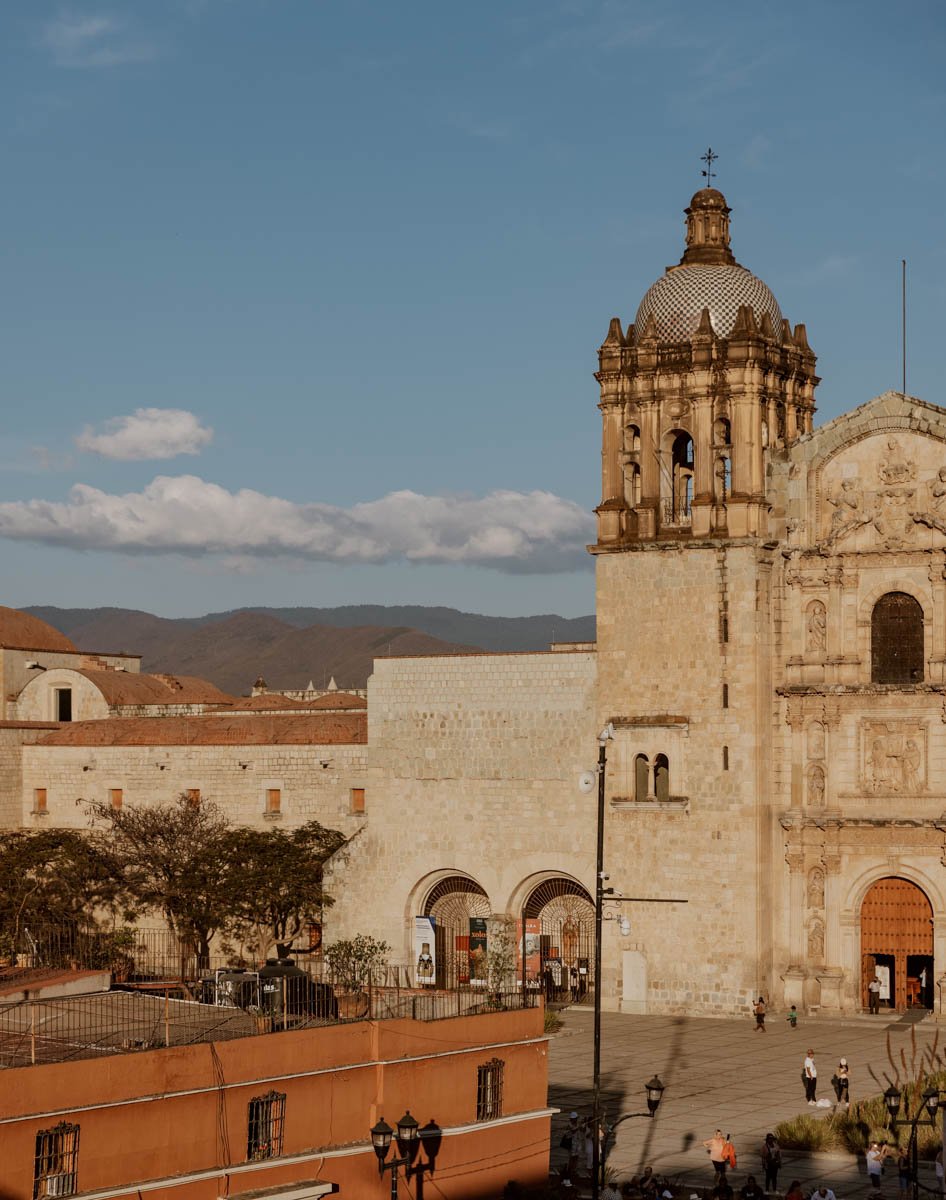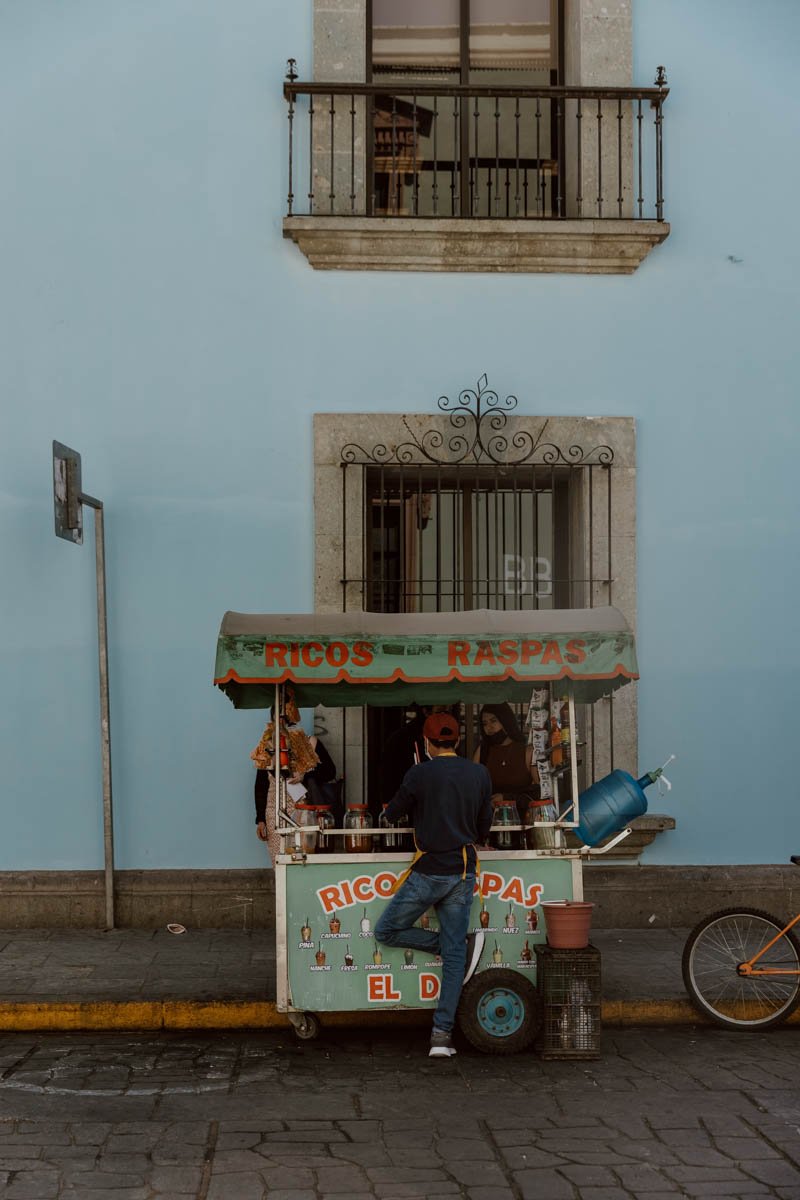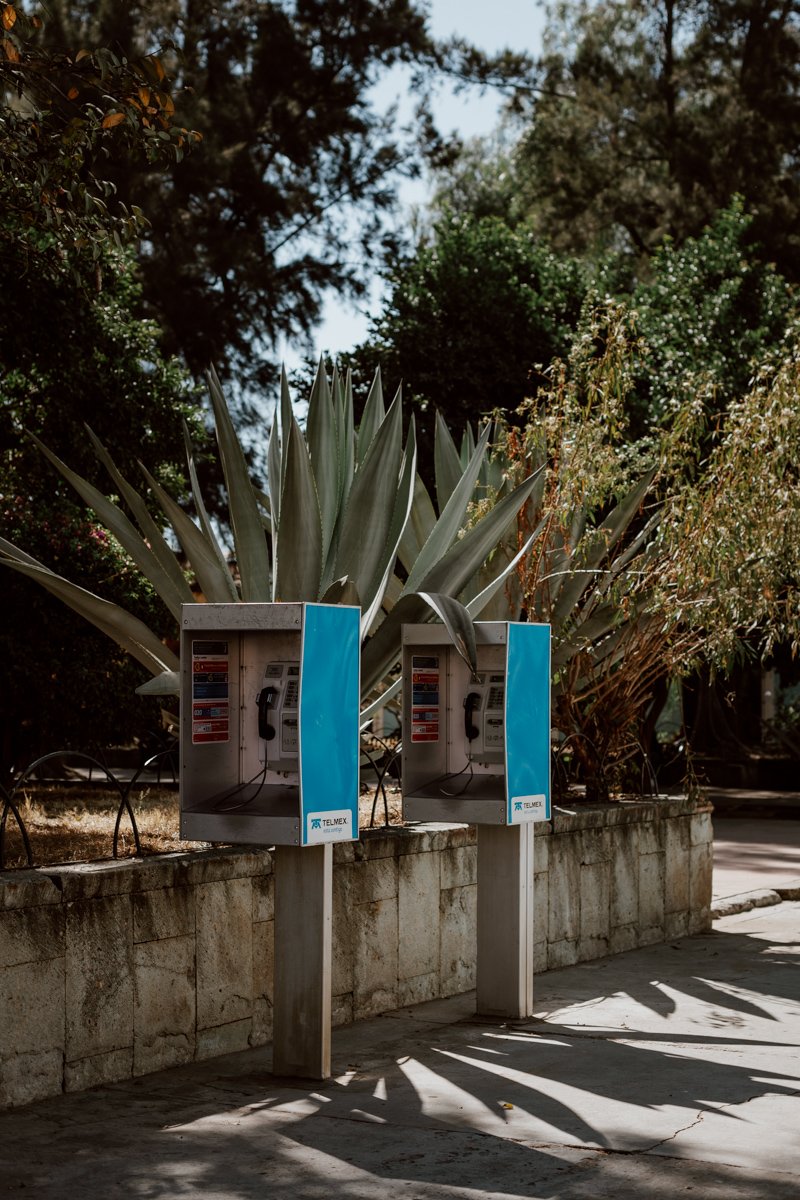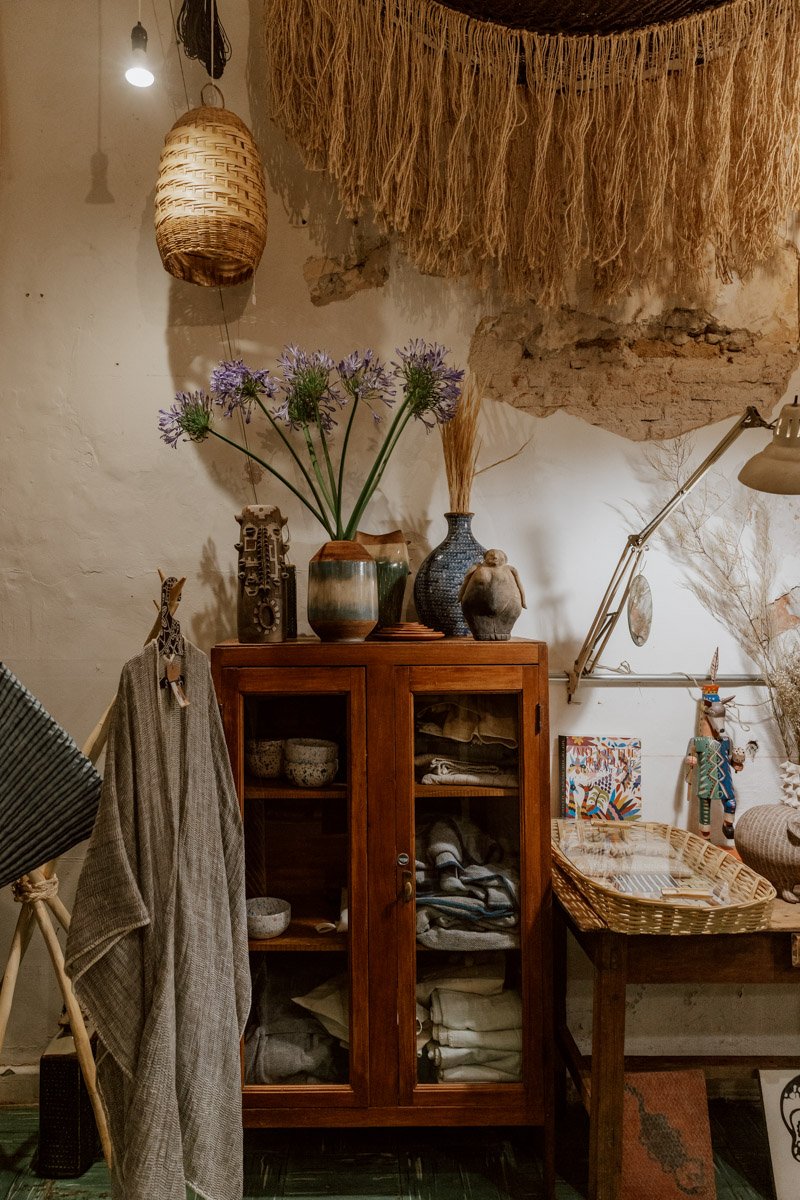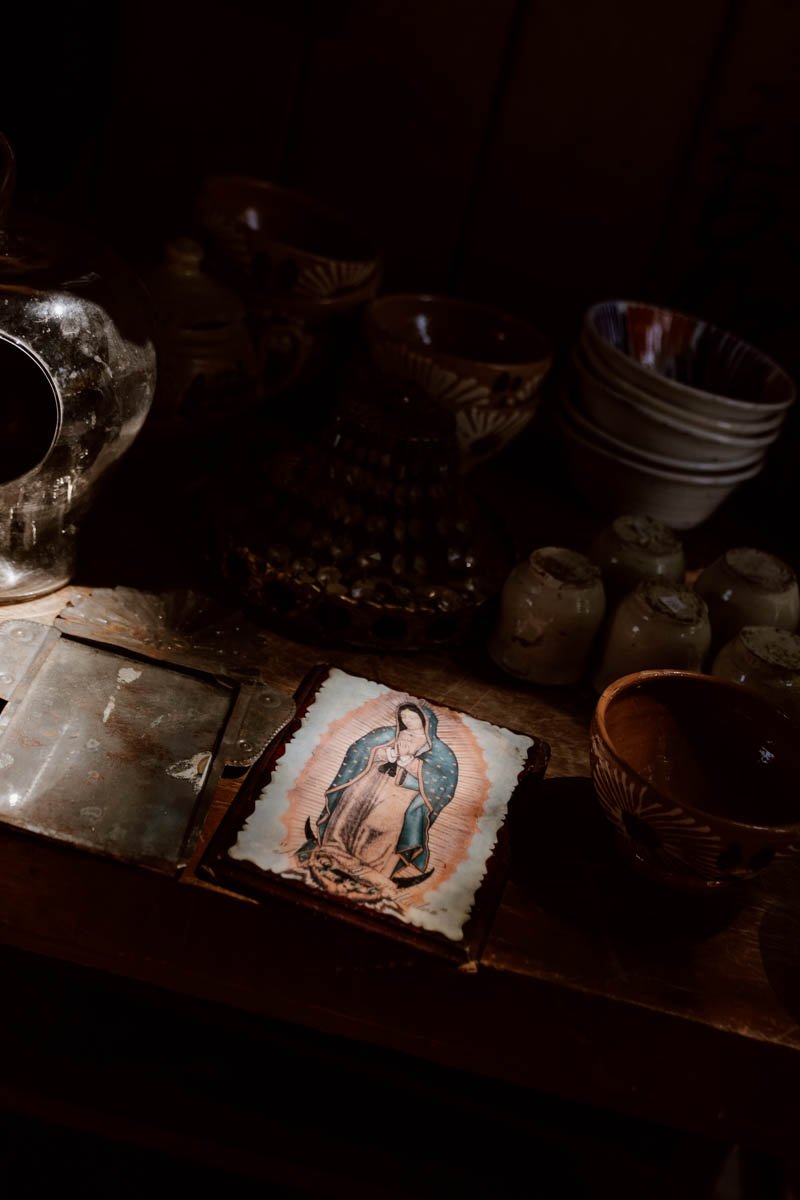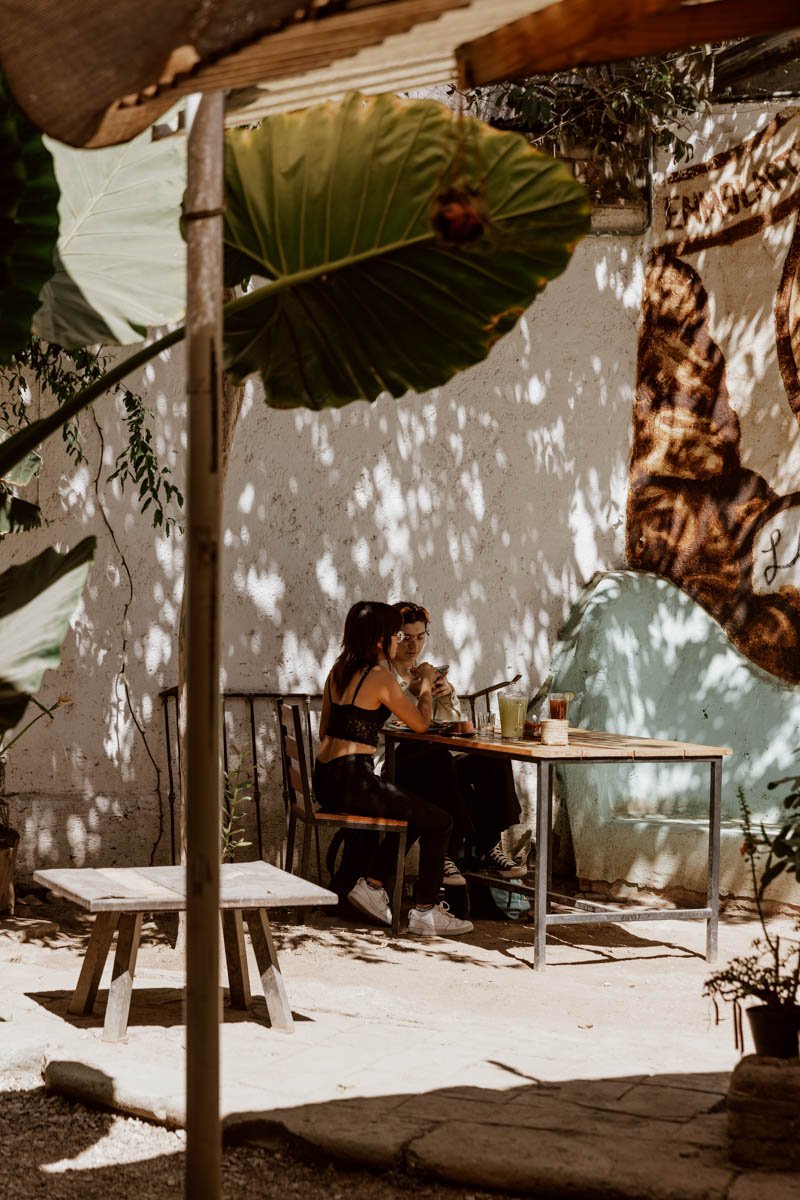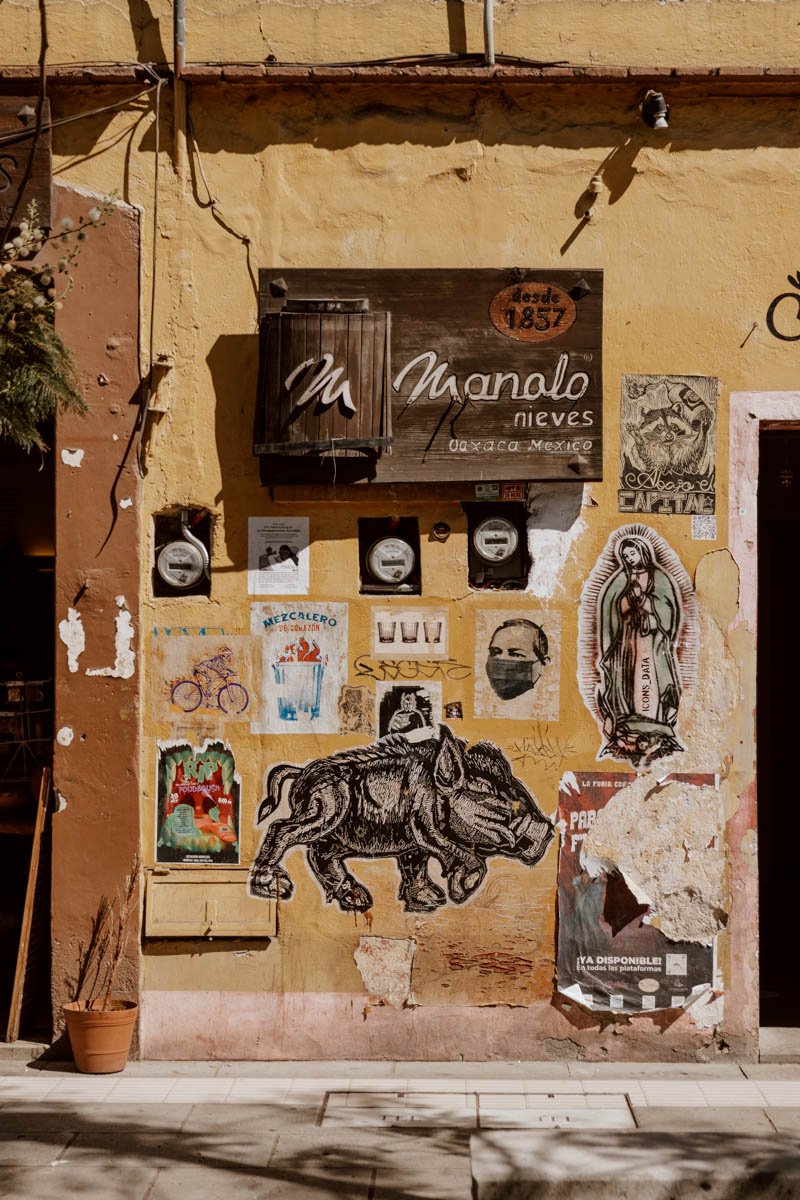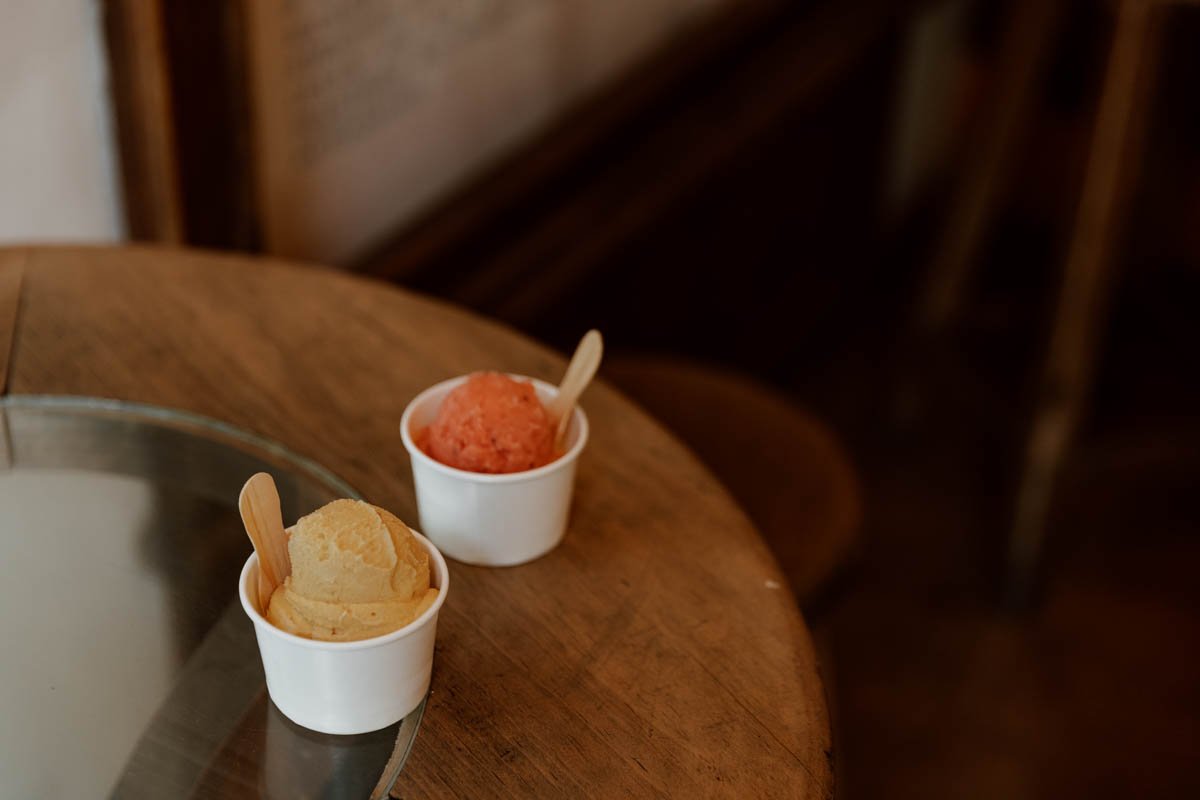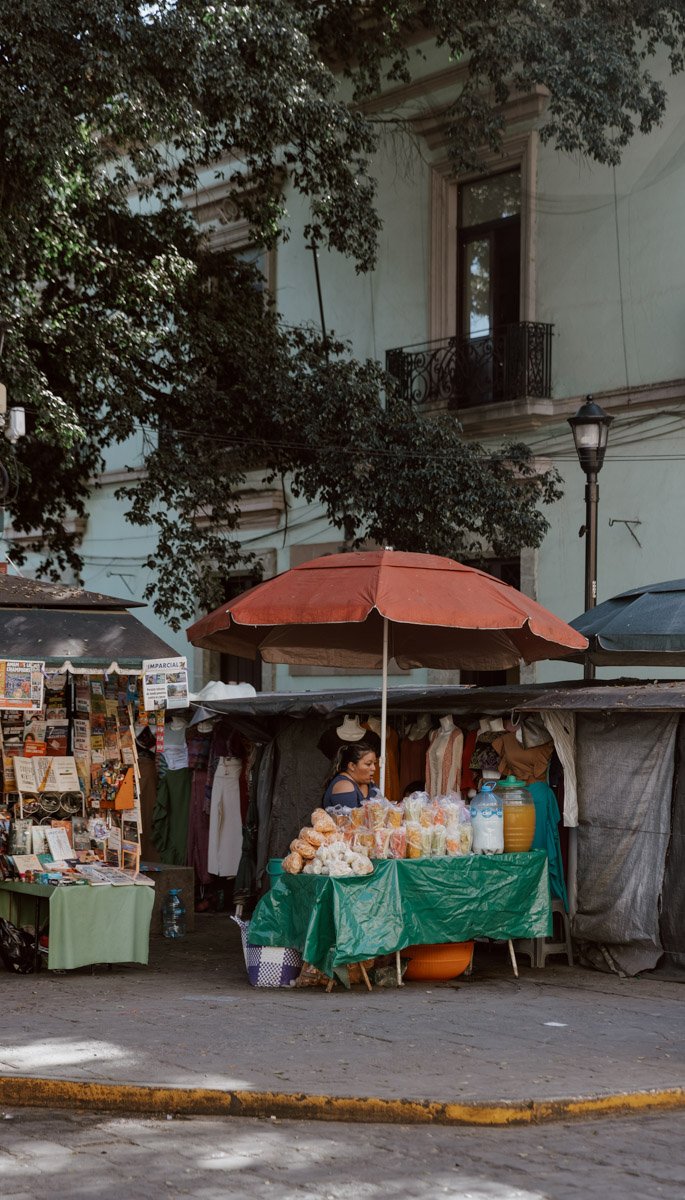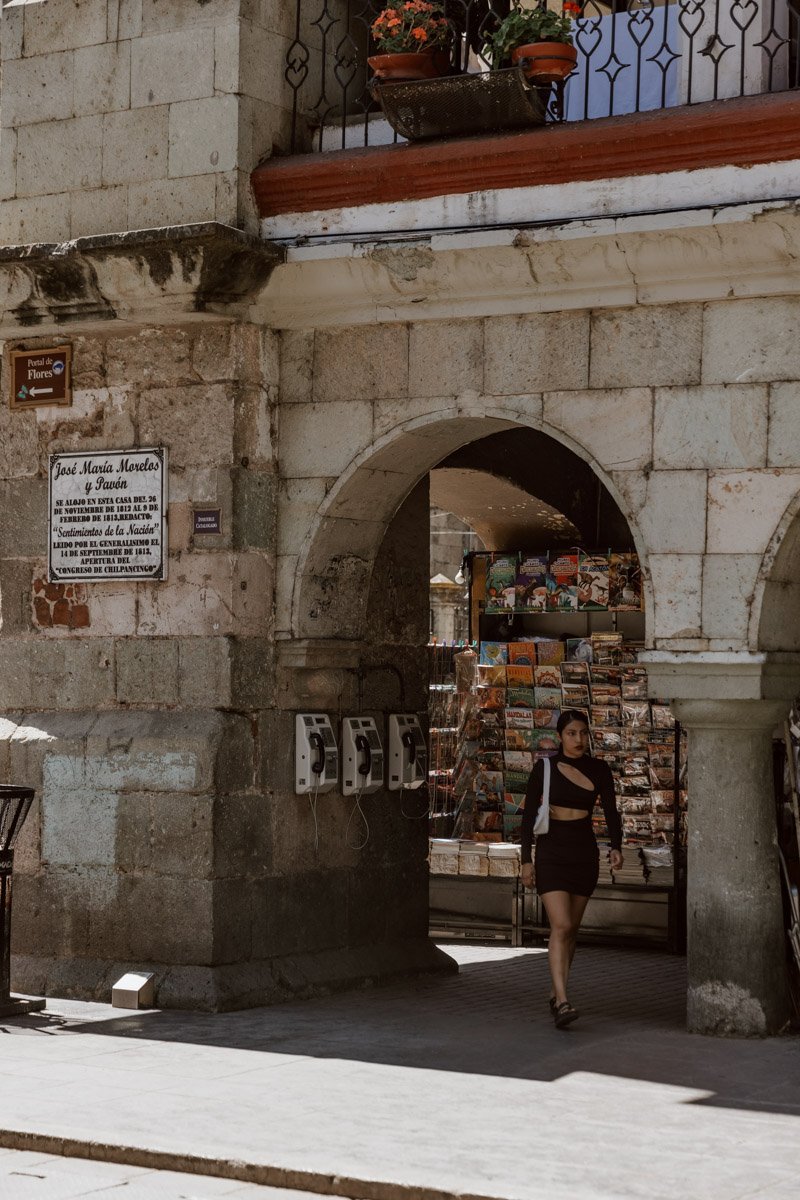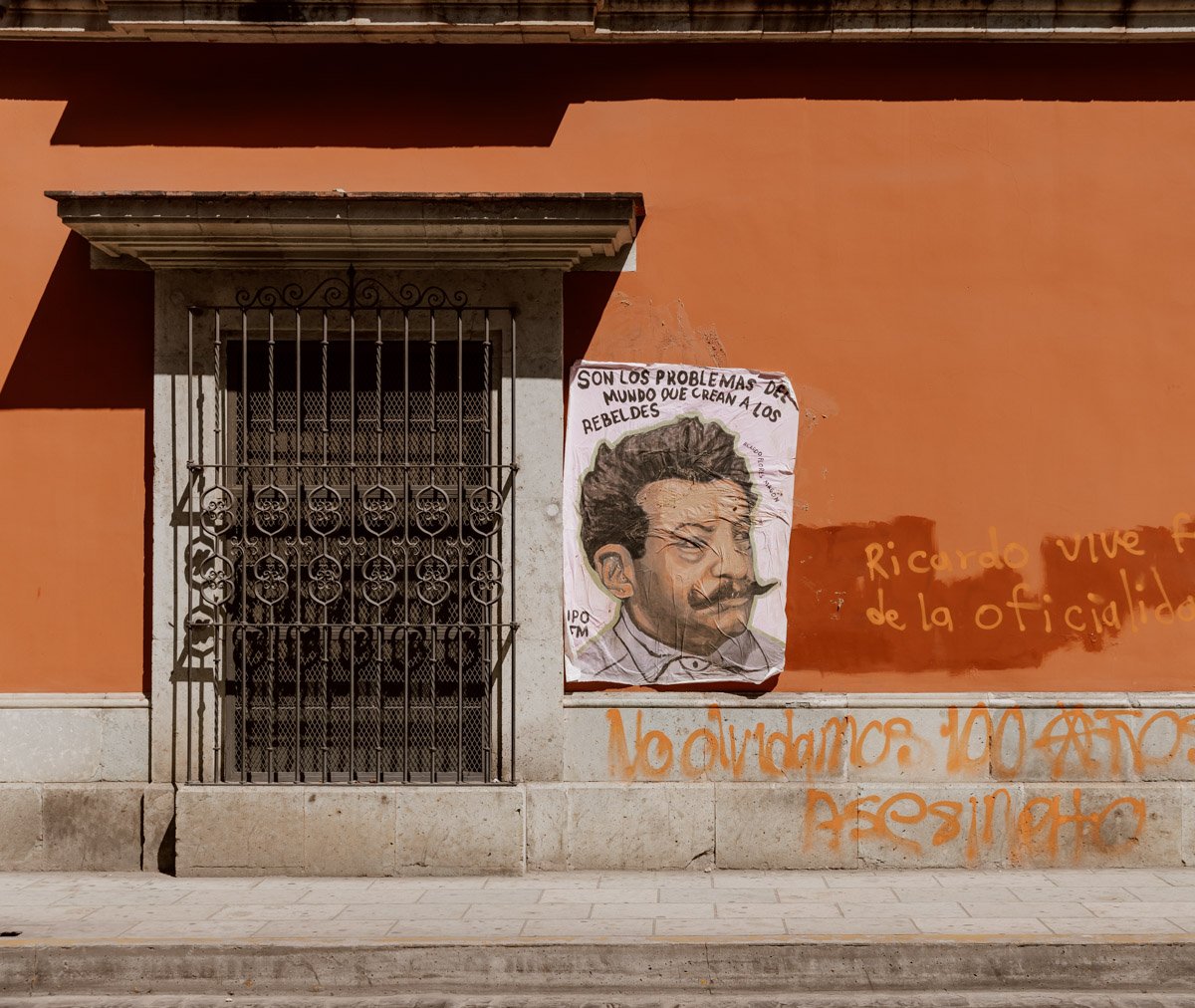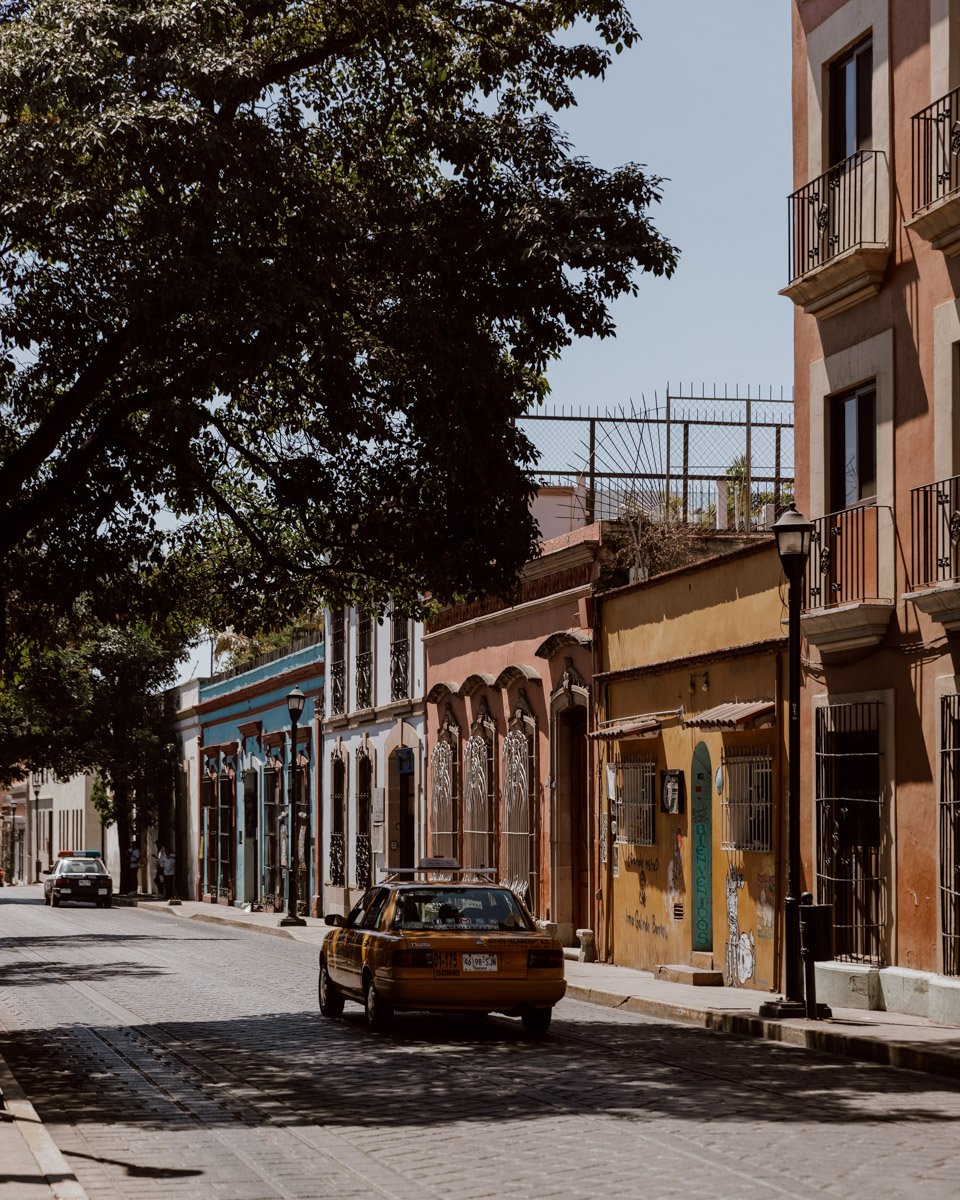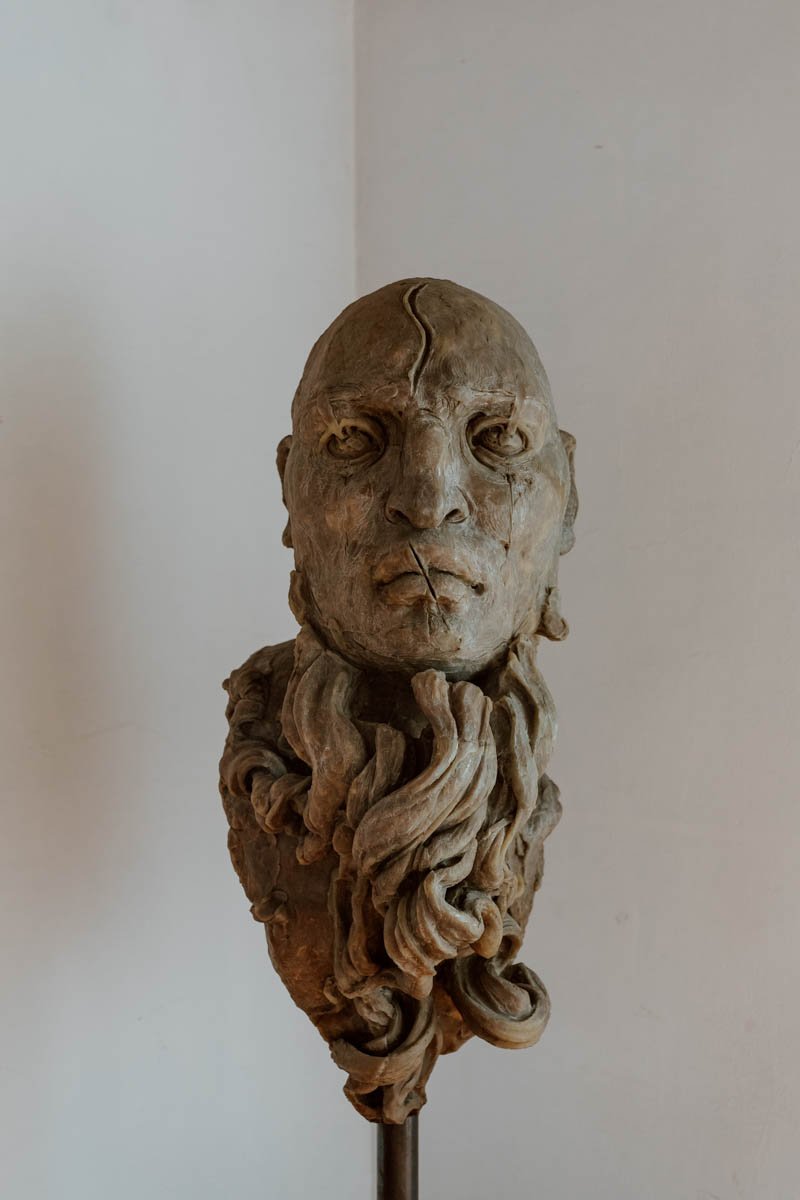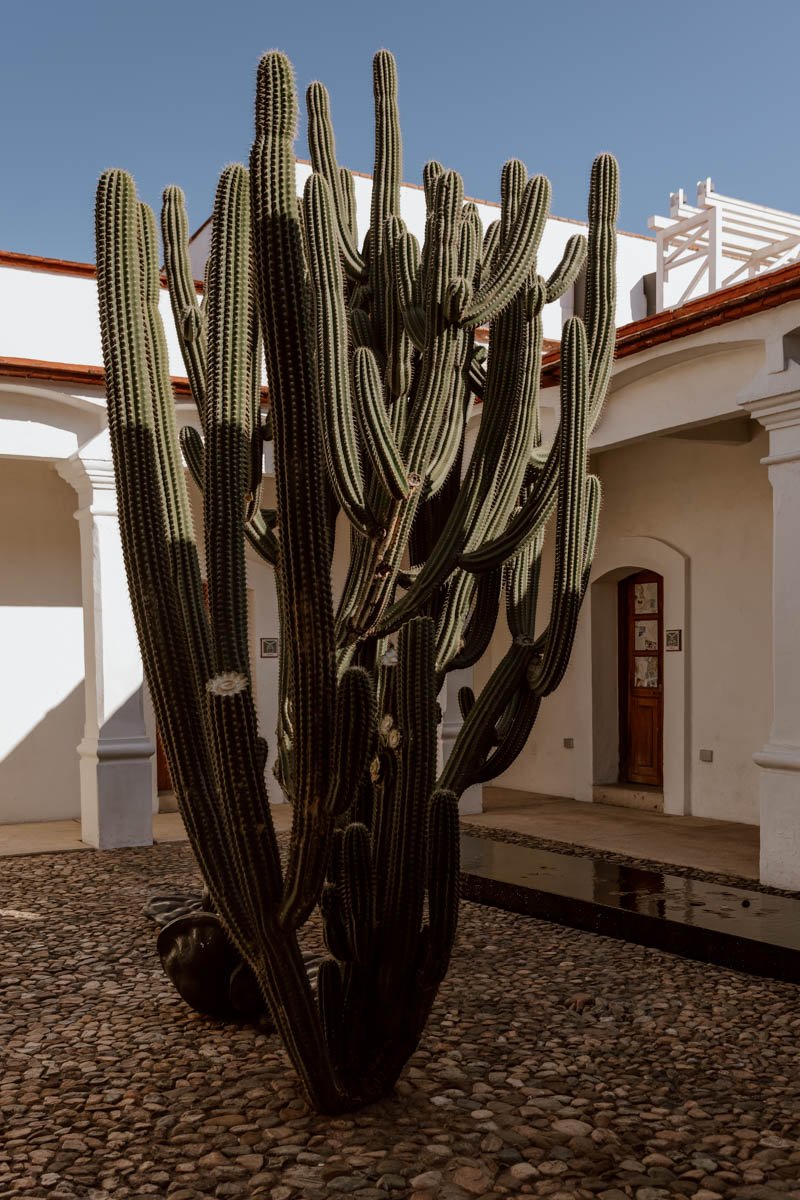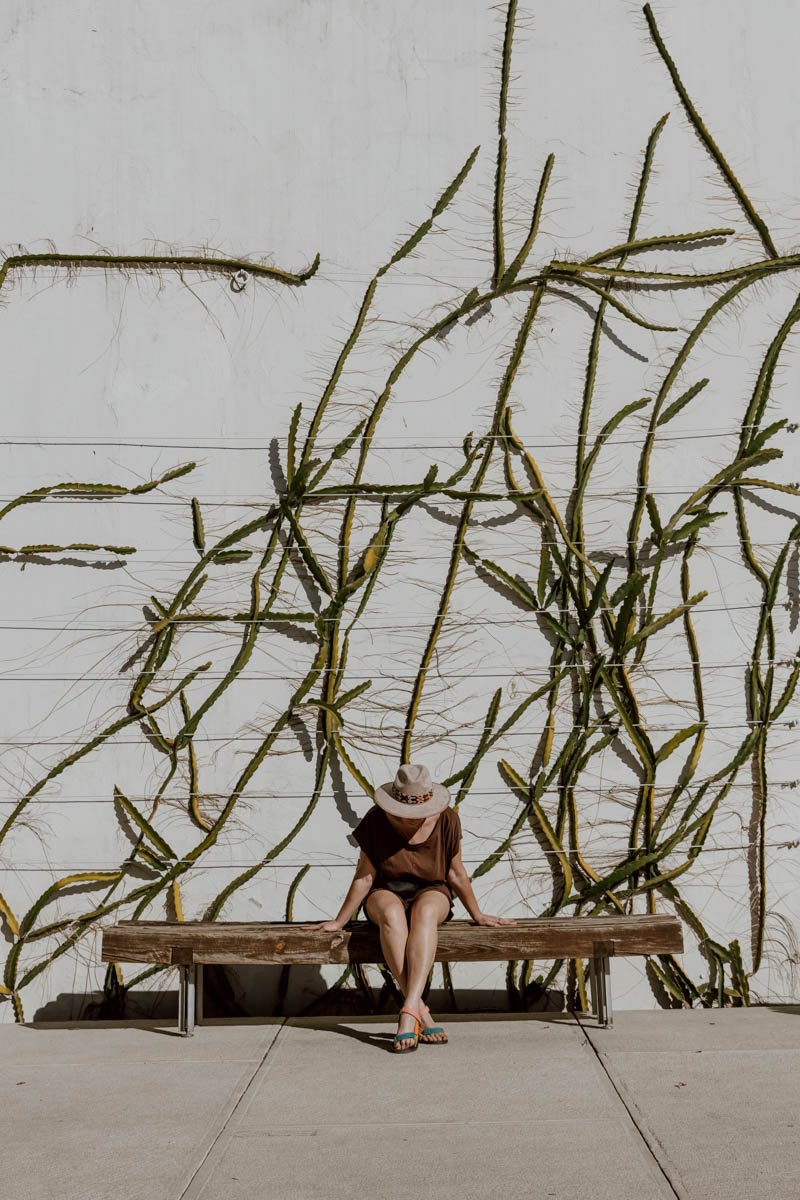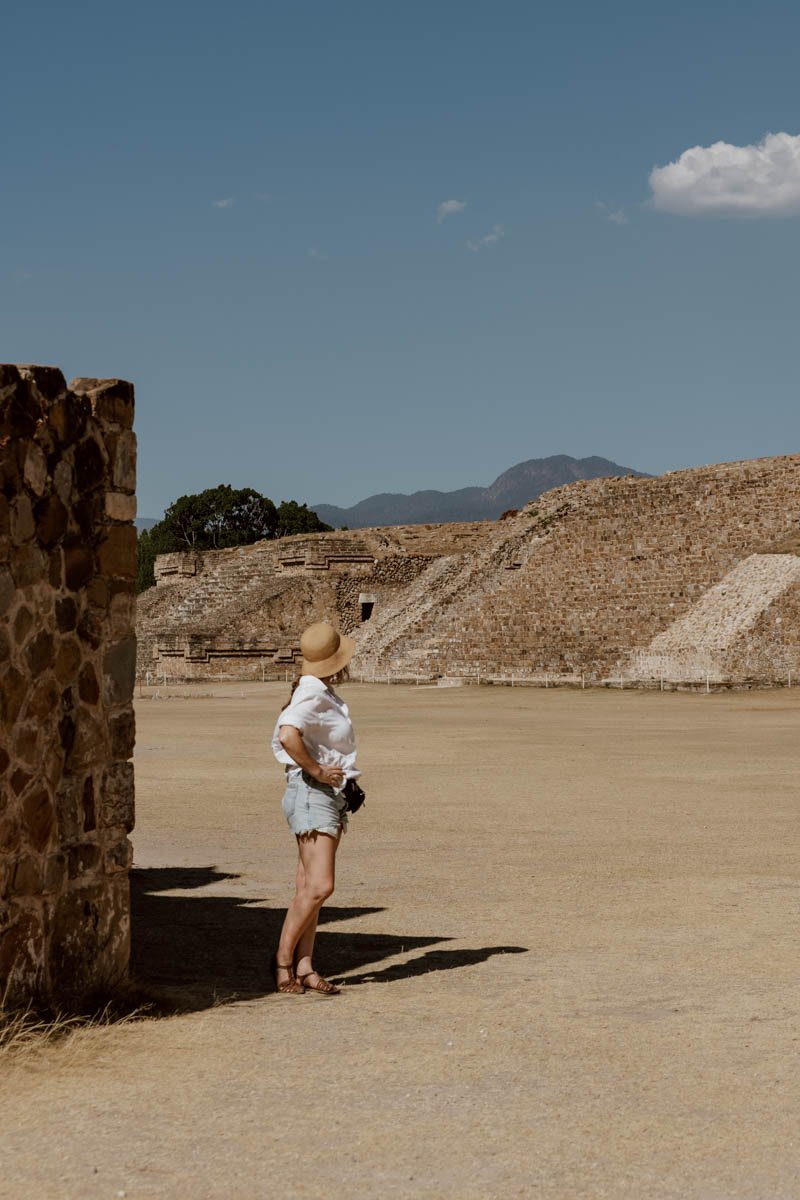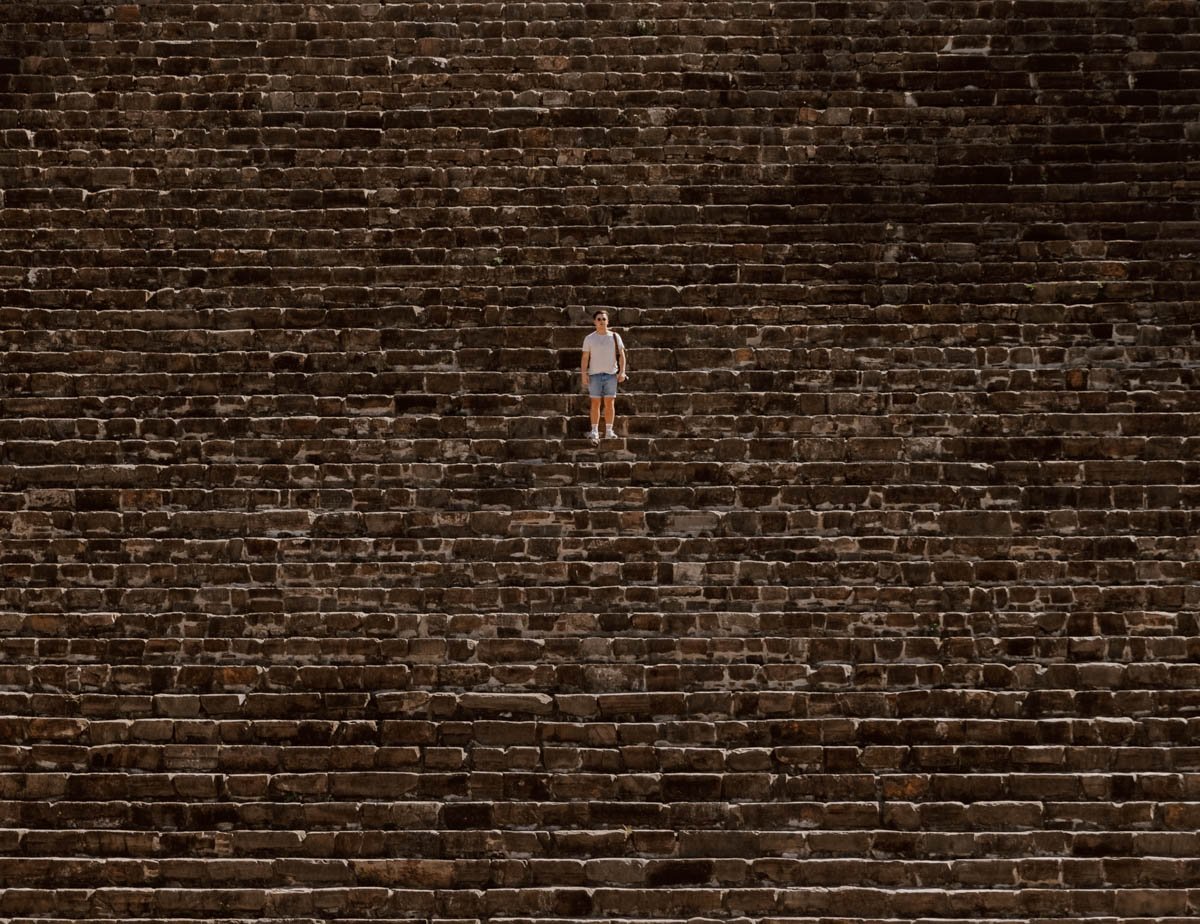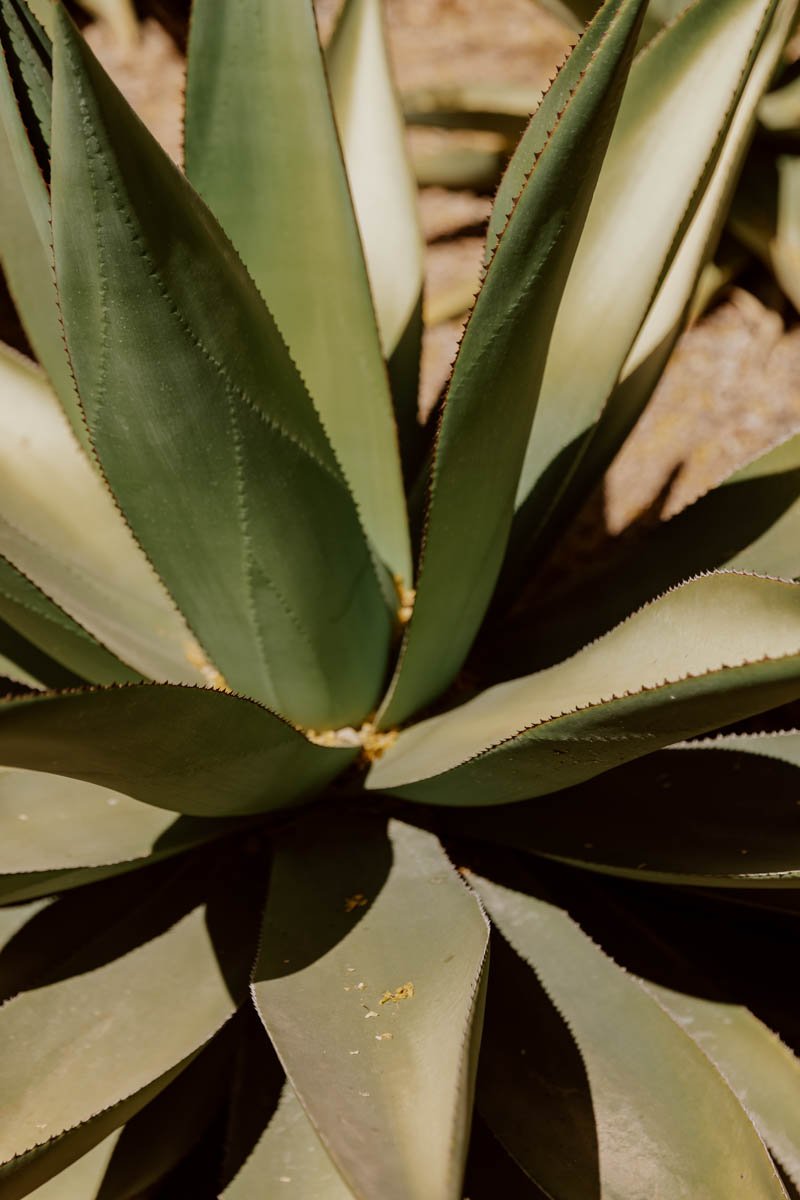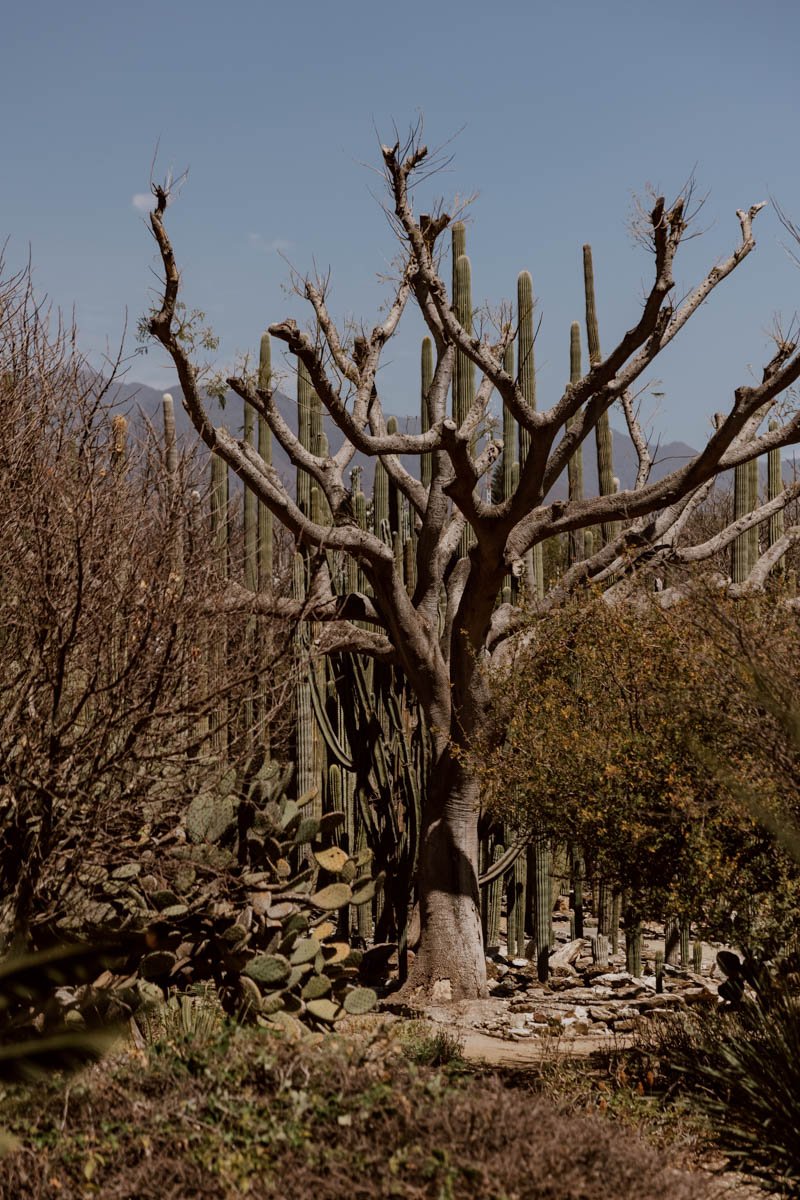Discover the very best things to do in Oaxaca City, the colourful foodie haven in southern Mexico that’s emerged as one of the country’s most in-demand destinations.
"That couple dress the best every week, but those two over there are the best dancers".
It's late afternoon in Oaxaca, and we're watching love endure.
In the public square before us - the zócalo - a dozen or so elderly couples are dressed in red and black. The men have generally played it safe with a combination of bright buttoned and pressed shirts, paired with sober dark trousers; the women split between dresses and blouses. The group meet regularly to dance here in the open-air, and this week's theme is Valentine's. Everyone has made an effort, and each man presents a rose to their dancing partner.
Hands rest gently on lower backs and shoulders.
Most of the dancers are over sixty, some over eighty, and at least one woman in a polkadot dress and comfy shoes is definitely north of ninety.
But when the music starts to play, age fades away.
If our trip to Oaxaca had a theme, then it would have been food and drink. The city in the state of the same name has a longstanding gastronomic reputation, famed for its moles and its mezcals. A decade ago, on our first visit as budget backpackers on a two-year trip in Latin America, we hadn't been able to devour as much as we would have liked. This time, with more money in our pockets and a better appreciation for the distinctive flavour profiles of proper Mexican food, we’d pledged to do it right.
There in the zócalo though, watching the slow shuffles and tender twirls of the senior dance club of Oaxaca, our hearts were as full as our bellies. Our new friends in the crowd, in prime position behind the seats, told us that it’s their favourite event in the whole week.
We travel for many things, but it's these unexpected 'moments in between' which are most memorable and, in this city, there’s a ‘moment in between’ on nearly every street corner.
Our guide to Oaxaca de Juarez will also help you fill both your belly and your heart. This compact, colourful, and cosmopolitan colonial city in southern Mexico is the capital of a large state which is, helpfully, also called Oaxaca.
Listed by UNESCO, and underpinned by a strong, diverse indigenous culture, the city has long formed a core part of backpacker itineraries. In the last decade though, spurred on by increasing numbers of direct flights from the US, it's evolved into a city-break destination for more affluent travellers, and an increasingly popular option for couples or groups to to split their time with the state's stellar Pacific coastline on one to two-week trips.
Whatever your budget or travel style, there will be a lot of crossover and similar themes, with the main difference being where you stay, the sort of restaurants and bars you frequent, and the numbers of tours / experiences you opt for versus doing it independently.
With our guide series, starting with 13 Wonderful Things To Do in Oaxaca, we'll help you plan ahead perfectly. In this post, we've shared the our favourite places in the city, as well as our personal recommendations for street food stops, restaurants, drinking holes, day trips, and unmissable experiences.
All you'll need to do is remember to drink a lot, eat a lot, and dance a little.
The Oaxaca City Essentials
Say / It’s pronounced ‘wa-ha-ca’, just like the restaurant chain
Eat / Tlayudas, memelas, and moles at Hierba Dulce
Do / Browse the food markets and ‘smoke alley’ in los mercados
Drink / Mezcal cocktails and local coffee
Book / A local-led Oaxacan cooking class or foodie tour
Look / Enjoy several excellent art galleries
Watch / A constant array of festivals, parades, and events
Buy / Handcrafted ceramics at Lia and Cooperitiva 1050°
Visit / The archaeological ruins of Monte Albán
Hotel / Casa Antonieta (luxury), Grana B&B (mid-range), Un Sueño Valle de Huajes (budget)
Hostels / Azul Cielo Hostel, Viajero Oaxaca
Airbnbs / The Clinic, our Airbnb, Kiyo, An Island in the City, Creole House, Casa Jalatlaco, Casa El Jardín, La Buena Espina
Find Your Inner-Foodie
You better arrive hungry.
Whilst Mexican food is rightly revered, Oaxaca has become a particularly sought-after destination for foodie tourists and the culinary curious.
For many, it's the gastronomic centre of the country, and daily rhythms revolve around eating.
Both the Bourdains and the boujies will be content here, and one can savour local dishes served up on plastic dishes atop floral table clothes at ma n' pa markets stalls, do a Oaxacan cooking class, or opt for the increasing selection of critically-acclaimed modern restaurants.
If you’re doing it right, you’ll spread yourself across all three.
So, what makes Oaxacan food so special? Like the rest of Mexico, much is based around the core ingredients of fire, corn, beans, and chillies, but it's the diversity of the sprawling state's climate, terrains, and people that sets it apart. There are over sixteen different indigenous groups in Oaxaca, with pre-Hispanic recipes and traditions a strong part of the culture, whilst every oaxaqueño has a fierce commitment to the regional ingredients grown from the Sierra Nevada mountains to the Pacific Coast.
It is the 'mole' however which is the most iconic and emblematic.
The sauce - pronounced 'mo-lay' - comes in a variety of colours and complexities, and is usually poured over meats or inside a tamale. No mole is the same, with some containing up to 30 ingredients and others prepared only for special occasions, but it's what you need to make a point of tasting at least twice in Oaxaca.
If in doubt, go for the mole negro, a thick, rich sweet-savoury-earthy blend of chocolate and chillies - just be aware that on first taste, you may not love it as much as you’re expecting.
The first one we tried, splurging our backpacker budget at a nicer restaurant many years ago, was disappointing. That was our fault though: we had expected something far less complex, and a sauce that was more instantly delicious and obviously 'Mexican'.
We appreciated future moles a lot more once we realised how distinctive they are, so just set your expectations and try a few at different places to form your own opinion! Also, if you've never had proper corn tortillas before (Brits tend to be brought up on flavourless flour ones by Old El Paso), it's a flavour and texture that is quite different, but you should learn to love it after a few tries.
Other foods you have you absolutely must try in the city include:
Memelas | Small corn tortillas, topped with bean paste and stringy fresh cheese.
Chocolate | Not what you'll find at the supermarket, Oaxacan chocolate is dark and rich, and used in many dishes. Hot chocolate is usually served with the sweet bread 'pan de yema'.
Tamales | A Mexican staple, the traditional Oaxacan ones are huge, wrapped in banana leaf, with some mole tucked inside with the filling.
Tlayudas | Folded tortillas the size of your heid, we absolutely adore them, and they deserve a whole section later in this guide on where to find the very best versions.
Tejate | This pre-Hispanic drink made from corn, cacao, and rosita de cacao flowers is delicious!
Travel Tip // With food being such a core part of the identity and experience of visiting Oaxaca, it's no surprise there are a range of cooking classes, specialist food tours, and workshops to introduce travellers to the ingredients, the cooks, and the traditions. We've shared a selection of the best and most highly-rated below:
· Flavours of Oaxaca Cooking Workshop | Find out more here
· Vegetarian Cooking Class with Market Visit | Book here or here
· Traditional Cooking Class with Minerva Lopez | Find out more here
Visit The Markets Of Oaxaca
In a destination where food is such a core part of the culture, visiting the bustling daily markets is essential to fully appreciating the raw materials and the producers that make it all possible.
They are also some of the best places to eat.
Oaxaca has several daily markets, which spill out on to the surrounding streets, and these vibrant, bustling nerve-centres are a treat for (and sometimes an assault upon) all of your senses. A world away from the bland, generic supermarkets of elsewhere, beyond the clash of sights, sounds, and scenes whirling around you, the Oaxacan markets also offer a fantastic setting to try authentic dishes for breakfast or lunch, spread your positive tourism spend, find esoteric souvenirs, and simply witness life being lived.
On shorter stays, you may only be able to visit a pair of neighbouring city centre markets - with the famous 'smoke alley' - but if you're here for longer, we encourage you to try and make it to a couple others on the outskirts which see far fewer travellers and far more campesinos.
Mercado Benito Juárez | Named after Mexico's first indigenous president, who was born just outside the city, the market has got a bit of everything under one roof: flowers, meat, yellow chickens, mezcal, chillies, cheese, fruit, fresh juices, mops, moles, coffee, and everything in between.
It's busy throughout the day, but we always find the best time to explore markets in Mexico and Central America is in the morning. It's open from 9am to 5pm, Monday to Friday, and you can find it here on Google Maps.
Just across from Mercado Benito Juárez, you’ll find Mercado 20 de Noviembre, and it's best to view these markets as a pair to visit concurrently. Filled with all manner of fondas and comedors big and small, this small and unpretentious indoor market is the place to come for breakfast or lunch at least once during your stay in Oaxaca.
It's most famous for Smoke Alley (Pasillo de Humo) - a dark gauntlet of piles of meat sizzling on barbecues and grills - where the air is thick around lunchtime. We're vegetarian so didn't get food from there, but the process is pretty simple for ordering your meat + sides, and the women on the stalls very friendly. Enter via the eastern entrance on 103 Miguel Cabrera (maps) to start with the full impact of Smoke Alley (or not, if you're particularly sensitive to the smell of meat).
A drunk local at nearby La Casa del Mezcal recommended Comedor Chabelita (maps) to us as one of the best local’s places to eat in the whole city, so we'll leave that tip with you.
Mercado 20 de Noviembre is open daily from 7am-7pm.
Mercado de La Merced | This is our favourite market to visit in Oaxaca city.
One that you have to make a little more effort to get to, it isn't quite as feverish an environment, so you can take your time to wander and chat a little more to stallholders before buying. We came for a breakfast of enchiladas and chilaquiles at one of the little restaurants by the entrance, where each table is covered by that quintiessential floral tablecloth.
It's an enjoyable enough 20-25 minute walk from the historical centre to Mercado de La Merced - named after the neighbourhood church - and you should take note of the curious little 'Artículos Religiosos' shop by the main entrance.
After the market, consider stopping by Unión de Palenqueros de Oaxaca (maps) for super locally brewed mezcal, whilst several of our tlayuda recommendations are also in this neighbourhood (more on those later). You're also right by the lesser-visited Jalatlaco neighbourhood if you'd like to explore another side of colonial Oaxcaca - on shorter stays we don't think it's essential though.
Find Mercado de La Merced here on Google Maps; it's open every day from 6am-6pm.
Central de Abastos de Oaxaca | A huge maze of stalls on the outskirts of central Oaxaca, Abastos attracts far fewer tourists than the others we've mentioned.
That may be exactly what some of you are looking to experience in terms of authenticity and life, but for first-timers or non Spanish-speakers, you may prefer sticking to the smaller, more manageable Benito Juarez and La Merced.
There's a bit of a negative reputation associated with Abastos (the main risk is pickpocketing), which is why we intentionally chose leave the cameras behind that morning; just be aware of your surroundings however and you shouldn't have issues. As in some markets we visited in Mexico City (guide published soon) and many elsewhere in Latin America, locals and stallholders are often keen to tell you to watch your valuables because they really don't want you to have any issues, rather than to scare you off. Their concern is sometimes a little alarmist, but always comes from a place of kindness.
Just behind Abastos, you can also stop by Mercado Lazaro Cardenas del Rio (maps)
Plan | If you would prefer to join a small-group tour of the Oaxaca markets, with lots of tastings and the chance to meet stallholders and producers, then consider the following highly-rated options:
· The Authentic Oaxaca Food Tour
· 2.5 Hour Tour of Mercado Benito Juarez & 20 de Noviembre
· The Oaxaca Gastronomic Experience
· Earth, Corn & Fire: Tasting the Roots of Oaxacan Cuisine - a 5.5 hour activity
Eat at Hierba Dulce
As much as we love Mexican food, as two people that stick predominantly to a vegetarian diet (besides the odd bit of fish and prawns if we’re on the coast), we sometimes feel a little left out when it comes to being able to enjoy many of the country’s meat-heavy specialities.
That’s why we absolutely adore finding places like Hierba Dulce, an incredible restaurant that specialises in plant-based versions of traditional Oaxacan specialities and prides itself on eschewing processed foods, cooking exclusively with locally produced agro-ecological food.
This is a place that any meat-eater should most definitely have on their list.
Not only did we get a chance to sample several traditional and complex moles (the green was a firm favourite), we gorged on the most delicious mushroom ceviche and a fresh nopales salad, enjoyed several memelas topped with homemade almond cheese, had a moment of pure joy with the enchiladas and inhaled several tetelas de quintonil (tasty triangle-shaped corn masa stuffed with black beans).
Everything is beautifully presented too, and will likely have you running to the nearest artisanal pottery shop to procure your own clay pots! (don’t worry, we’ve got a few suggestions later on where you can buy those).
We felt absolutely no regrets about returning for a second time during our week!
One thing to note is that Hierba Dulce is a relatively popular spot, and both times we visited there was at least one small-ish group and it would fill up quite quickly, so if you’re travelling with several people or don’t fancy a wait, we’d recommend booking ahead via their website.
Given Oaxaca’s reputation as a bit of a foodie mecca, it should come as little surprise that there are an abundance of in-demand restaurants in the city, with many popping up in the last few years. It would take a fair few weeks to cover them all, but some that we recommend are:
Los Danzantes (maps) | Remember that restaurant we splurged on the first time we visited Oaxaca? Well, that was Los Danzantes, and it’s still recognised as one of the city’s best. Focussing on Oaxacan flavours and dishes but with a modern twist (with the odd bit of fusion cuisine - the blue corn gnocchi sounds incredible), it’s part of the Slow Food Mexico movement, with an emphasis on kilometre zero produce and sustainable practices. The space is also gorgeous. Bookings are essential, and can be made on their website.
Origen (maps) | Open since 2011, this stunning, fine-dining restaurant is a bit of a stalwart on the city’s gastronomic scene, creating beautifully presented dishes that harness that the flavours, ingredients and history of the region. We only popped in here to grab a coffee and have a chat with the staff, but if we ever return we’ll absolutely be making a reservation.
Los Pacos (maps) | A local-style restaurant that is widely considered to make some of the city’s best moles. To begin, you’ll enjoy short tasting of all seven different moles whilst the staff explain the ingredients and significance. Then, once you’ve picked your favourite, you’re free to order your main course with your preferred mole. Fantastic if you’re intimidated by the different options and don’t want to risk ordering something you might not enjoy at one of the more expensive restaurants.
Casa Oaxaca El Restaurante (maps) | Recognised as one of the city’s best restaurants, Casa Oaxaca is owned and run by chef Alejandro Ruíz (a local oaxaqueño who’s passion for his home-state’s cuisine has led him to open several restaurants across the country), and delivers innovative dishes that expertly combine tradition a contemporary twist, all enveloped in Oaxaca’s diverse flavours.
Another place a few of our Instagram followers recommended was Criollo (maps), but we couldn’t make it out there.
Explore The colourful Streets
Built on the midway point between two rivers and a mountain, and once known by another name, Oaxaca is a beautifully well-preserved example of a 16th century Spanish colonial town in Latin America.
As they continued south in search of gold and territory - with disastrous consequences for the indigenous population - the Spanish Conquistadors founded Villa de Antequera under decree from King Charles V in 1526.
Alonso Garcia Bravo (an architect as well as marauding Conquisatdor) played a key role in the design of Villa de Antequera, as well other cities in colonial Mexico.
Whilst few details remain of his personal philosophy, his work in Oaxaca and other regions reflects the broader architectural trends and urban planning principles of the Spanish colonial period, including the centrality of plazas, uniform grid and street layouts, and a prioritisation of grand buildings linked to two key instruments of colonial power: the church and the state.
The preservation of this layout led to Oaxaca's designation as a UNESCO World Heritage site, and its charismatic and photogenic appeal underpins the city's desirability as a tourism destination.
With the signature splashes of Mexican colour on the walls, the wonderful typography of hand-painted signs and menus, the harsh interplay of shadow and light on the single-storey buildings, and the not too infrequent photogenic taxi or VW beetle trundling by, it is a joy to explore.
This is the section where we'd usually now recommend you to simply 'get lost' in the streets, but that's actually quite difficult given the rigid uniformity of the grid layout! However, simply wandering around the historical centre with time on your side, money in your pocket, and a few museums, cafes, and landmarks in your Google Maps is absolutely one of the best things to do in Oaxaca.
Just watch out for some of those cobblestones!
Did You Know? // Following independence in 1821, the name was changed from Villa de Antequera to Oaxaca. Stemming from Nahuatl origin, the language of the Aztecs, it is believed to mean "in the nose of the squash" or "place of the guaje (a type of tree)"; the renaming was part of a broader effort to emphasise indigenous and national identity during a period of significant political and cultural change (literal decolonisation, which isn't a new term or approach at all).
If you're keeping up from the markets section, it should be clear who inspired the Juarez part to be added in 1872!
To get more context on the Spanish takeover and colonial period, and the indigenous death and exploitation that was inherent in the model, start with this Brittanica article
Don’t miss Tlayudas
You are in for a treat.
The tlayuda (roughly pronounced ‘t-lie-ooda’, with a very soft ‘t’) is sometimes referred to as a 'Mexican pizza' but having spent a lot of time in Naples, Italy, we think it's sensible to leave comparison at the door.
That isn't too besmirch this typically Oaxacan dish, but they're simply not the same thing.
Take a massive freshly rolled corn masa tortilla, throw it on a blackened coal grill for a few minutes, then slather on some refried beans, stringy Oaxacan cheese, shredded lettuce, and then (if you're a meat eater) generous portions beef or pork, drizzles of the house hot sauces, fold it and then try to get your lips around it without everything spilling out the sides, and you're there.
This is a ubiquitous ands lip-smackingly delicious street food - a meal on its own - and you simply must have several whilst you're in Oaxaca. These are particularly excellent on the way home if you've had a few too many mezcals...
We're vegetarian (pescatarian by the coast), and the good news is that the veggie option (the sencillo) is standard on all menus, with the option to add avocado.
A few our our personal favourite places for tlayudas in Oaxaca are:
Tlayudas El Negro (maps) | A great place with amazing tlayudas. After a long bus journey from Mexico City, this was a random pick on our first night in the city, and by god it was a good choice. It's a local joint with nightly music or dance performers (but not the sort that make it feel like a tourist cliché), and they do one thing very, very well. We'd go back right now.
Further research tells us they have also have another restaurant here.
Tlayudas Libres Doña Martha (maps) | We loved this place. Super local, with tlayudas cooked on a small, very well-used and seasoned barbecue on the street and staff watching telenovelas.
Tlayudas Doña Luchita (maps) | On the outskirts of the historical centre, by Mercado de la Merced, we unfortunately didn't make it here but it was recommended to us.
On our first visit, we loved ‘I Love Tlayudas’, but recent reviews sound like it's gone downhill.
We were recommended Tlayudas Las Ánimas (maps) but it was unfortunately very disappointing. It's run by really nice people in a low-key courtyard, but clientele was mostly travellers and the portions of the fillings (essential to a good tlayuda) were really poor, so we can't recommend.
Drink Great Local Coffee
Go back more years than we’d like to mention to our very first trip to Mexico, and it’s fair to say that we were somewhat culturally unaware.
Our Spanish was pretty awful, Andrew didn’t really like the taste of corn, and our coffee preferences extended to whatever the hipster-friendly East London coffee shop down the road was serving.
We knew we liked the taste of coffee and we knew that we didn’t like the taste of bad coffee, but we were far from understanding the complexities of various beans from around the world, and even less about the process of farming, producing, and delicately roasting it.
Well, fast forward nearly a decade and things have changed a tad: our Spanish is pretty decent (thank you Michel Thomas*), we’ll demolish corn in all its forms, and we can distinguish the taste not only of beans from different continents, but individual countries sometimes.
And Oaxacan coffee? We looooove Oaxacan coffee.
Indeed, the state is developing a serious reputation for its small-scale bean production in the highlands of the Sierra Madre. It’s best enjoyed at the fantastic array of independent coffee shops exclusively serving up their own roasts of locally grown coffee beans, or roasts from producers elsewhere in the state, in understated, cool environments.
All very hipster yes, but 100% worthy.
Some are ideal for digital nomads, some are better for brunch stops, whilst others are more a pit-stop for a V60.
There's too many to mention in this post so, instead, we've sorted you out and shared them all in this 7 Best Coffee Shops in Oaxaca post.
Travel Tip // Whilst the colonial streets of Oaxaca are well preserved, this city is no museum.
There's a lot of life and a lot going on. The sizeable student population helps this - whilst frequently camping out to protest or scrawl revolutionary graffiti - and the scene is being added to all the time by locals returning from overseas to open new restaurants and businesses, and the increasing influx of digital nomads and ex-pats.
The part of the historical centre where the hipster / student / ex-pat influences are best seen is in and around Calle Porfirio Diaz. Along it, as well as some great examples of the form on bright, colonial walls, you'll find two street art collective studios + shops/galleries - 2020 Arte Contemporáneo and Siqueirosgallery (maps) - as well as a vintage shop, a couple of cool cafes, a great little bakery called Pan con Madra (maps), the Oaxaca Brewing Company (maps), and several other companies cleary catering more to a certain clientele.
Casa Angel is a popular hostel in the area.
It's also got our absolutely favourite drinking hole in Oaxaca, the very traditonal, very non-hipster Cantina Salón de La Fama. This has been on the corner for around for about a century, and once you go through the saloon doors, do your bit to not be a sightseer - just order a beer, a michelada, or q mezcal, grab a table, and enjoy the atmosphere.
*get 30% off our preferred Michel Thomas Method courses with discount code ‘MTMADR’
Mezcal Tastings, Tours & Distilleries
There has been a surge in the awareness and popularity of mezcal and tequila in the US and Europe in the last decade, fuelled in part by a ton of celebrities launching their own booze brands.
Carlos Santana, Bryan Cranston, P Diddy, Rita Ora, The Rock, Kendal Jenner, and Justin Timberlake have all got one, whilst George Clooney sold his for $1 billion.
No longer therefore is Mexican spirit only associated with bad memories of cheap shots on a student night out or an attempt to get through a work-do with colleagues you can't stand.
There are three golden rules to keep in mind here though:
1. All tequila is mezcal, but not all mezcal is tequila
2. Oaxaca is mezcal country
3. You should sip, rather than shoot
Mezcal is made from various species of the agave plant, whilst tequila is primarily produced from the blue agave variety. On the first sip or two, you may not be able to tell the difference but, just like whiskies and wines, there is a whole flavour profile to appreciate and discern between the two and between mezcals grown in different regions, with different methods, or different types of agave.
Deeply rooted in tradition across the state, Oaxaca is the foremost place in Mexico for mezcal. As the spirit's popularity has boosted, there's been a proliferation in larger, more corporate distilleries, but there are no shortage of small-scale, artisanal operations in and around the city.
So, one of the best things to do in Oaxaca for the uninitiated is to get acquainted with mezcal through tastings, distillery tours, and heading to a handful of excellent mezcalerias in the city; those who already love it can savour the chance to go deeper, meet producers, and discover a whole range of brands and homebrews that don't get exported.
Eating loads and drinking booze, and getting to pretend it's all a cultural experience: is it any wonder that Oaxaca is so popular!?
Importantly though, in Mexico, one doesn't really do 'shots' of mezcal (although we have most certainly seen locals young and old knocking back the stuff at speed then chomping on an orange), but rather besitos de mezcal i.e. sipping it slowly
And if hard liquor doesn't appeal, just bear in mind the following: it would be like going to Scotland and shunning a few drams of whisky. Travel is about curiosity, trying new things and challenging preconceptions and, if you really don't like it sipping it straight alongside a beer, then it goes wonderfully in a cocktail.
A few mezcal experiences and tours to check out are:
The Mezcal Journey | This highly-rated tour brings you out to the agave fields, before visiting an artisan distillery to learn the process of making mezcal. There’s then an unlimited (!) tasting, followed by lunch.
Oaxaca: Mezcal Adventure | Introducing you to producers at different scales, techniques, and styles, this tour from Oaxaca visits three distilleries and includes lunch.
Mezcal & Mole Tasting | Led by an expert, this is more specialist and allows you to get much better acquainted with two of Oaxaca’s bedrocks. There’s a maximum of six per group in the tasting, and the emphasis is on family-produced mezcals and moles, and how both play such an important role in the Oaxacan palate.
Mezcal Mixology Workshop | A more hands-on introduction to the spirit, this workshop will get you acquainted whilst creating three mezcal-based cocktails.
You should also make a point of stopping by a a couple of mezcalerias. In contrast to our first visit to Oaxaca, there's been a real boom in trendy mezcaleria / cocktail bars in the historical centre. Personally, there are too many now - jumping on the mezcal trend and Oaxaca's increasing appeal as a bougie city-break destination - with a number often empty, the prices high, and the atmosphere sterile.
Supply and demand will result in an equilibrium, and we prefer the low-key local's bars which also offer a range of mezcals behind the counter, but these are still a great place to sample a few different types, learn from the staff, and imbibe a cocktail or two.
A few good picks are Mezcalería Cuish (maps), La Mezcalerita (maps), and Mezcalería In Situ (maps), whilst Unión de Palenqueros (maps) is refreshingly old school and lesser visited if you want to buy something small-scale.
One of our favourites after dark though is the very local, very raucous backroom at La Casa del Mezcal (maps), especially when there’s a competitive jukebox.
Watch Parades & Festivals
Whether you plan for it or not, there’s usually some sort of festival or parade going on in Oaxaca.
It’s truly a wonderful part of visiting the city, adding much colour, music, and costume to the streets. The frequency of festivals is underpinned by the richness of the state’s diverse indigenous communities, which much of Mexico did not retain during colonialism, but Oaxaca’s indigenous heritage and traditions endured. Exact numbers can vary depending on a few factors, but it's generally recognised that there are over sixteen indigenous ethnicities in the state of Oaxaca, including Zapotecs, Mixtecs, Mazatecs, Triquis, Chatinos, and Huaves.
A key reason for this feature being particular to Oaxaca is the mountain terrain leaving many groups to develop in relative isolation, and to be better sheltered from incursion in the colonial and post-colonial eras.
Many communities from towns and villages outside Oaxaca descend upon the city centre for parades celebrating this heritage specifically, as well as to join more general Mexican celebrations.
We didn’t plan our dates around any particular festival, but still ended up watching three distinct parades during the week! We’ve shared more information on the main Oaxaca festivals, as it would be a great time to be in the city:
· The Guelaguetza is the biggest festival in Oaxaca, celebrating the cultural and ethnic diversity of Oaxaca’s eight regions and 16 communities It takes place on the last two Mondays of July, but there are lots of side-events in the weeks leading up to it.
· Carneval takes place on the Saturday before Lent (usually around the first week of February), with communities arriving by the bus load in amazing costumes and traditional dress to parade through the historical centre with lots of music, dancing, and firecrackers. This was the festival we were accidentally there for, and it definitely stretched out across several days!
· Noche de Rábanos (The Radish Night), dates back to 1897 and takes place every 23rd December. People created hand-carved Christmas scenes with radishes (no idea why).
· Dia de los Muertos / Day of the Dead is celebrated across Mexico, and it’s become quite well known and evolved from its traditional roots in some places. It is celebrated on November 1st and 2nd, but technically starts the night of October 31st
· Semana Santa - the Easter Holy week - is a huge deal across Latin America. Processions are common, but they are far more sombre and religious in nature (though not all are). This time is also one of the busiest holiday periods all over Latin America - with prices going up and availability limited in any tourist place - so we don’t recommend planning to visit during it unless you’ve planned well.
Plan // One of the most popular day trips from Oaxaca - independently or with a tour - is Hierve El Agua. We’ve shared everything you need to plan ahead for the pools, petrified waterfalls, and public transport in our Hierve El Agua guide.
Visit Museum of Cultures of Oaxaca & Templo de Santo Domingo de Guzmán
Dating back to the 16th century, the baroque marvel of Templo de Santo Domingo de Guzmán was built by Dominican friars on the site of a former Zapotec temple. Legend has it that the church's construction began after a vision of Santo Domingo de Guzmán, the Dominican founder, appeared in a dream, but construction spanned over 200 years, with the final touches completed in the 18th century.
The façade is generously detailed, telling the story of Oaxaca's complex cultural, spiritual, and ethnographic history, and the building and its blue agave dotted pretty little square, is a key landmark in the city.
Inside, the interior is lavish, with gold leaf stucco and exquisite altars, and Carviaggio-esque interplay between light and shadow in the corners and arches. It is worthwhile to take a moment inside to admire it but, as the sign says, and applies for any place of worship in Mexico and elsewhere, this isn't a museum.
Visitors are very welcome, but you should dress and act appropriately (hats off, shoulders covered), and give space, silence, and priority to anyone coming here to pray.
Adjoining the church is a former convent, repurposed as the Museum of Cultures of Oaxaca - arguably the most important museum in the city. It showcases artefacts from pre-Hispanic to colonial times, and is the best place to get more context on the history of Oaxaca and its civilisations.
The 14th century treasures discovered in Tomb 7 at Monte Albán in 1932 are the most revered and spellbinding part of the collection, with the turqouise entrusted skull stealing the show. Wandering around the gorgeous old convent is a worthwhile activity all on its own, whilst the views out over the Botanical Gardens are excellent, but it is frustrating that there are not more explainers in English.
Give yourself at least an hour for the museum, but set aside a minimum of two if you want to see, read, and photograph extensively.
Where + When | You can find the Museo de las Culturas de Oaxaca here on Google Maps. It's open 10am-5.30pm Tuesday-Saturday, and 10am-3.30pm on Sundays. Closed Mondays.
The church is generally open every morning and afternoon, but visitor access will not be possible during religious services.
This square and crossroads in front of Templo de Santo Domingo de Guzmána (maps) intersects with Calle Macedonio Alcalá and is a popular part of the historical centre. You'll arrive here naturally as part of your wanderings, or make a beeline to start / end your day here.
For a great sunset view of the Templo, mezcal cocktail in hand, walk over to Calle Ignacio Allende and head to the rooftops of Terraza Los Amantes, Praga Coffee Bar, or Vaca Marina (unfortunately, one of the cocktails we had at the latter - a fancy place - was not good). Hotel Los Amantes is also on this street.
Tickets | The church is free to enter, whilst the full-price entrance for the museum is M$90, and free entry for children under 13.
Note that the two have separate entrances and it's not possible to buy tickets in advance for the museum, and queues are quite common at the ticket office.
Buy Artisan Pottery
If you're visiting Oaxaca on a shorter, standalone trip, then be sure to leave room in your suitcase.
We could have bought so many pretty little things, principally because of two fantastic shops doing everything the right way to preserve and promote the traditions of fired clay, and sustainably bridging the gap between traditional techniques and modern tastes.
At each, you will find several unique, meaningful, handcrafted pieces to carry home:
Cooperativa 1050º | A great place to source authentic, traditionally made Oaxacan pottery and support an excellent organisation at the same time.
A cooperative of artisans from seven communities brought together by a love of clay, they aim to keep the pottery traditions alive whilst creating beautiful pieces. Whilst they supply, ship, and sell outside of Mexico, this store in Oaxaca is the only one run by the cooperative. We still regret not purchasing their Fire & Clay book.
Find it here on Google Maps, and it's best tagged on with your wanderings of the ‘Northern Quarter’ (see later in the post).
LIA | Beautifully decorated and curated, their ceramics are responsibly sourced direct from artisans. They also have textiles and fabrics with a similar ethos. The quality and selection is amongst the best you'll find in the whole state, and you will not find many of these sort of ceramics elsewhere (trust us).
Also, trust us when we say that if there’s a piece you love, don't assume it'll still be there a day later when you finally decide to buy it (isn’t that right Andrew…)
You'll find Lia on Calle 5 de Mayo (maps), opposite the disappointing Selina Hostel. It's open 8.30am-8pm Monday-Saturday, and 11am-7pm on Sundays.
You’ll find several more ateliers and artisan shops dotted cross the historical centre, but Lia and Cooperativa 1050º are the most important in our book.
These two, combined with the Museo Nacional de Antropología in CDMX, really turned us on in a big way to pre-Colombian art. In all honesty, it had never really appealed to us in the past but is now amongst our favourites. If you’d like to know or see more, then definitely pop by the Museo de Arte Prehispánico de México (maps) whilst in Oaxaca.
Not far from Lia, in the entrance to the library (maps), you may find the lady who had set set up her own table of bric-a-brac and vintage pieces; we purchased an old icon of Lady of Guadalupe from her that proudly hangs in our kitchen today. You can usually find some stalls in Parque Labastida, just opposite, but selling the more standard and mass-produced souvenirs you can find all over the state (in our opinion, you’ll also find too much of this at the Oaxaca Artisan Market)
For proper cowboy stuff, pop into El Caballo Mixteco (maps) by Mercado Benito Juarez.
Plan // The 12 Best Oaxaca Beaches
Explore The Northern Quarter
It's not actually called the 'Northern Quarter' but it feels like the most suitable description for this cool enclave north of the historical centre.
Principally based around the top of Calle Macedonio Alcala (maps), a colourful pedestrianised street with various cafes and restaurants on one side and access to pretty little Calle de Xólotl, it's really pretty, and feels like a distinct neighbourhood.
Calle Macedonio Alcala leads to/from the churches and zócalo and markets of the historical centre, so it's also a good startpoint or endpoint for a day of exploring the colonial streets!
There are a few particular places to keep in mind a you explore:
La Cosecha Organic Market (Mercado Orgánico La Cosecha) | Due to the calmer, clearer, and more curated set-up, if you don't speak Spanish and/or it's your first time in Mexico, this is an ideal environment for a gentler introduction into so many of the fantastic regional foods you'll find in the other markets.
They also make vegan and veggie options much clearer than the markets.
Founded by producers and artisans, this small market is now one of the most popular things to do in Oaxaca; you can really take your time to see what's on offer at the produce and food stalls around the central benches. Stop by for breakfast, lunch, or just a quick bite to try your first bowl of tejate, plate of memelas, pulque, or mole tamales. Note that, when we popped in, it was exclusively travellers browsing and eating here, and the prices therefore a little higher and atmosphere quite different.
Cosecha market is open 9am-5pm Wednesday to Sunday, and you can find it here on Google Maps.
LA CLÍNICA | Just along the street is this super cool, albeit slightly confusing cultural venue. Part coffee shop, design store, and exhibition space in a really cool old medical clinic, it was not long opened when we were there. It will either not survive another 12 months, or will may emerge as one of the coolest and best things to do in Oaxaca - let us know!
They also offer artist residencies and have a couple of stylish Airbnbs - The Garden Room and The Clinic Suite - which feature as some of our best picks in Where To Stay in Oaxaca.
Museo de las Nieves | Don't worry, it's not another museum. Instead, this multi-generation family business is the best place to try your first 'nieve’. It's a traditional version of ice-cream or sorbet/granita, depending on whether you opt for the milk-based on or not (but it's more ice than ice-cream). All-natural with no fake flavours, you will find them sold in carts all over the city on a hot day, but the pricier Museo de las Nieves is considered to produce some of the city’s best.
They are also very happy for you to sample quite a few before settling on which to scoop in a cone or cup ('tuna' by the way is cactus flavour, not fish, whilst guanabana or maracuya are always a good pick for us). Some also include mezcal!
Open every day from 12-9pm, find Museo de las Nieves on Google Maps. La Mezcalerita is next door, and the litte cantina is a good shot for a an alternative form of refreshment on a hot day.
Wander up the very pretty little Calle de Xólotl, and you'll find Café "El Volador" (featured in our Best Oaxaca Coffee Shops list) and Cooperativa 1050º, the excellent pottery shop we mentioned earlier. From there, you could opt to continue on a long, gradual walk up the incline to eventually come upon a view back on Oaxaca from the Auditorio Guelaguetza and other spots, but it's really not worth it.
Travel Tip // On Calle de Xólotl, you will see various signs up from the local community about no noise and respecting their home. There are also several rooftop bars and hostels that appear to have recently closed or in a state of uncertainty. This used to be quite a popular late-night area, which has obviously caused issues for those who live here. Please let us know as / when things become clearer.
Hang Out In The Zócalo (Plaza de la Constitución)
Plaza de la Constitución, better known as the zócalo, is the epicentre of daily life in Oaxaca, and there's always something going on in the massive public square.
We don't mean that in a casual sort of way: there is literally always something going on, and usually it's several things all at once with loudspeakers.
Balloon sellers, clowns, gentleman buskers, beggars, parades, senior dancers, crooners, protesters, young lovers, tourists, popcorn vendors, artists, exercise classes, political campaigners, religious preachers, shoeshiners, and student agitators. It's a charming melting swirl of life being lived, with a series of official and unofficial events, and the zócalo is so large that all operate in tandem most afternoons and evenings.
At the heart of the historical centre for over 500 years, and the lynchpin of Alonso Garcia Bravo’s architectural masterplan, Oaxaca was largely designed around the zócalo. Flanked by the cathedral and government buildings, it's the natural meeting and socialising point for los oaxaqueños and, to its credit, the local government funds and organises many of the weekly events.
You will walk through the traffic-free zócalo several times a day whether you intend to or not, due to it weaving the city together via five entranceways. There are restaurants and bars in the arched collonade on two sides, and it's a reliable spot to sit and have a coffee or beer and watch the world go by, but not somewhere we'd recommend eating specifically.
The bars / cafes are pretty much all interchangeable, but Tierra Mestiza isn't a bad shout.
Personally speaking, sometimes the zócalo was too much for us if our curiosity or energy wasn't at its highest. At other times, its dervish energy and noise was a delight to observe with a cold beer in hand.
Did You Know? // The main square of many Mexican towns and cities is called the zócalo. The name is was borrowed from Mexico City's huge central plaza, with the name meaning 'plinth' in Spanish. We think the one in Oaxaca is far better than its namesake in the capital though.
Where + When | You can find the zócalo here on Google Maps, and it’s a sensible point of reference for all your wanderings around the historical centre of Oaxaca.
It’s busiest and most crowded in the afternoons and evenings, but try not to walk through it alone late at night.
Travel Tip // You will often be asked for money if you’re having a drink here - either by buskers or beggars - and we will leave it up to you about whether it’s appropriate to give something. However, please remember that giving directly to children, no matter how heartbreaking, does not break the cycle and can worsen their situation. Despite its burgeoning travel reputation, Oaxaca remains one of the poorest states in Mexico, and we would instead encourage you to consider donating to an organisation like Oaxaca Streetchildren Grassroots, which helps children to stay in education.
Pueblos Mancomunados
A big part of our travel philosophy at Along Dusty Roads is to directly support community tourism projects, and Pueblos Mancomunados is the one we selected in Oaxaca after an Instagram follower glowingly recommended it.
The ecotourism initiative brings together eight villages to offer guided hikes and overnight stays, with the aim of encouraging positive tourism andd creating sustainable jobs.
We joined them for a two-day/one-night guided walk on a trail between two villages in the Sierra Norte, but had a mixed, quite disappointing experience.
We would be able to look past this a little more, and wouldn't hesitate to encourage you to check them out, if the cost wasn't so high (£345 / $450 for two of us!); that was the discounted rate as we didn't require an English-speaking guide. It simply isn’t worth that much money - and it’s increased since we did the experience a few months ago
We gave our feedback to Pueblos Mancomunados, as we would love the project to thrive, and we really do hope they take some of the points on board.
You can find out more on packages, routes, and prices by visiting their website or popping into their office in central Oaxaca (maps).
hit up the Art galleries
There’s a great arts scene in Oaxaca, and visiting one or two of its galleries and museums is essential. We’ve shared our favourites below to help you choose:
MUSEO DE ARTE CONTEMPORANEO DE OAXACA
Across two floors of a lovely colonial property, they have a variety of mediums and styles in their collections, all leaning toward the modern.
We spent about an hour and a half here and highly recommend it.
The Details | You can find Museo de Arte Contemporaneo de Oaxaca on C. Macedonio Alcalá 202 (find it here on Google Maps). Entry is MX$50 per person but do note that the museum is temporarily closed for remodelling - see their website for details on when it will re-open.
Museum of Oaxacan Painters
This was the best art gallery we visited in Oaxaca, but it may not always be for you.
The reason is that the Museo de los Pintores Oaxaqueños (MUPO), housed in a beautifully restored 17th-century building, doesn't have a permanent collection. As the name suggests, its goal is to promote local artists (dead and living, famous and not), across its four temporary exhibition rooms, so your experience will depend on what they’ve got on at the time.
MUPO has a leaning toward contemporary art, but no strict categorisation beyond that, and Raúl Herrera's work was most impactful when we were there, but its web presence isn't great so you'll have to just turn up and take a chance.
The Details | Open every day 9am-6pm, you can find Museo de los Pintores Oaxaqueños on Av. Independencia 607, just off the zocalo (find it here on Google Maps)
We recommend 30-45 minutes here, depending on how much you enjoy or engage with the works.
It’s free to enter for local and foreigners, but donations welcomed at the entrance before or after you leave.
Museo De La Filatelia (MUFI).
Now, a stamp museum is hardly going to get you giddy with excitement (and if it does, perhaps you need to take a good like in the mirror), but this one is far better than you would assume.
Philately - the collection and study of postage stamps - is celebrated within the whitewashed colonial building and, though the interest is niche, the space and purpose is modern, well-curated, and child-friendly.
Across 200,000 pieces stored in pull-out shelves and vaults, there's a variety of letters from Frida Kahlo to her doctor, stamps signed by Babe Ruth, and the temporary exhibits are more like those you’d find in an art gallery And, if you view the stamps as tiny pieces of art design, specific to each country's culture, then you can see the appeal.
The Details | Free to enter within the cultural centre, there's also a library and coffee shop.
Open every day from 10.30am-8pm, and the entrance is here on Google Maps.
Visit Monte AlbÁn
On our first visit to Oaxaca, we decided to skip the former Zapotec capital.
It was a real highlight of our second trip.
A UNESCO World Heritage Site atop the rugged landscapes of the Valley of Oaxaca, Monte Albán proudly stands on a flattened mountaintop as a monument to the ancient civilisations of Mesoamerica.
A vast complex of tombs, temples, pyramids and stunning panoramic views, it’s just a 20-minute drive from the city centre but feels like a world away.
Founded in 500 BC, and continuously occupied for 1,300 years, comparisons with Machu Picchu in Peru, Tikal in Guatemala, and the Lost City in Colombia are apt.
It is seriously impressive, and in a beautiful setting.
For some of you, with only so much time to devour and guzzle all the gastronomic delights of Oaxaca, pre-Colombian archaeological ruins may not be at the tippy top of your list, but we’d encourage you to reconsider if you’re in the city for more than two days.
It’s straightforward to go there independently by taxi or the regular shuttle bus, whilst there are a variety of half-day tours that will take care of all logistics and include an English-speaking guide.
We’ve shared everything you need to know to decide, plan, and travel better in our dedicated guide: How To Visit Monte Alban from Oaxaca
The Jardín Etnobotánico de Oaxaca
The important thing in our travel guides is honesty and personal insight (and hopefully some nice words + pictures), and our role isn't to make everything sound unmissable if our experience didn't wed with the expectation.
And, unfortunately, the Botanical Gardens isn't a place we recommend everyone visit, particularly if you're on a tighter budget or schedule.
Established in 1998, it was the brainchild of renowned Oaxacan artist Francisco Toledo, who sought to create a space that not only showcased the stunning diversity of local plant life but also celebrated Oaxaca's indigenous cultures and their deep connection to the land.
Spread across nearly two acres, it's a meticulously curated oasis in the historical centre, housing a vast collection of native plant species, including a remarkable assortment of agaves, cacti, and medicinal herbs. Thanks to the state of Oaxaca's diversity of microclimates and topographies, the range of flora is wild!
Within the walls of the old convent, it is a beautiful space to explore, and a microcosm of the Oaxaca's diverse climates and flora.
However, visitors are only able to see the gardens as part of a guided group tour. That's no bad thing in and of itself, especially if it's aim is to educate and prevent damage to the plants, but the schedule and approach limits enjoyment.
Unfortunately, in the sweltering afternoon sun, our group was far too large, escorted along like schoolchildren along the set route, not allowed to take too many photos, and scolded if you lingered for too long at the back. It was a real shame, and meant it was not an enjoyable experience for us and others, despite the evident beauty and our interest in learning.
Green-fingered travellers in Oaxaca should still prioritise it, but note that there is also only one English-speaking tour per day (11am, Monday to Saturday).
We speak Spanish so joined the shorter, cheaper, more frequent tours in that language, but they really could do with adding another English tour, as it's often over-subscribed and people turn up too late to secure a place (we've shared some tips below to avoid disappointment).
Where + When | The Jardín Etnobotánico de Oaxaca (maps) is in the historical centre, under a 15-minute walk from the zocalo. Visits are only possible as part of the guided tours, running from 10am Monday to Saturday.
The gardens are one of the most popular things to do in Oaxaca for tourists and, whichever tour you join, we recommend arriving 10-15 minutes before the start time to ensure a place.
Tickets & Tips | There is only one English-speaking tour of the Jardín Etnobotánico, running at 11am Monday to Saturday. Groups are limited to 30 people (still too large in our opinion), and we recommend arriving at 10.30am to secure a place in busier months.
As far as we are aware, it is still not possible to reserve or buy tickets in advance, and tickets cost M$100 per person (free for children under 12).
The English-speaking tour lasts two hours, and the heat can be too much for some people. Bring your own hat and plenty water, but note that they do also have hats for people to borrow for the tour.
For more options, you can join the one-hour tour in Spanish, which departs at 10am -11am -12pm, and 5pm Monday to Friday, whilst there's no 5pm tour on Saturdays. It costs M$50 per person (free for under 12s).
If you would really like to see the gardens, rather than get context and ask questions, you can join the Spanish tour if you're a non-Spanish speaker, but we're not sure we'd we'd recommend that.
You can find more information on opening times and tours on the official website - and if try your luck at contacting them directly, you might be able to reserve a space.



